Physical Address
304 North Cardinal St.
Dorchester Center, MA 02124
Adequate oncologic margins and enough future liver remnant (FLR) with proper inflow and outflow are the pillars for any successful strategy in liver surgery (see Chapter 101 ). Given that tumor-free margin remains the mainstream of any oncologic surgery, liver regeneration has been considered the most suitable path to address successfully both surgical radicality and safety for advanced oncologic liver involvement. By treating the diseased part to hypertrophy, the FLR has been a practical translation from the 1990s , to now (see Chapter 102C ). Nevertheless, the failure of portal vein (PV) embolization (PVE) to obtain an adequate FLR has limited this approach both for colorectal liver metastases (CLMs) and hepatocellular carcinoma (HCC). , Thus a temporary debulking surgery splitting into two operations the organ clearance with or without PVE was proposed for multiple bilobar CLM: the two-stage hepatectomy (TSH). , The relatively high dropout because of tumor progression between the two procedures induced some authors to shorten the interval between them by combining in the first operation the right PV ligation, the clearance of the left liver, and the division of the two hemilivers, creating the so-called associated liver partition and PV ligation for staged hepatectomy (ALPPS) , (see Chapter 102D ). The surgical community has learned from the ALPPS procedure that the liver division together with the PV ligation can boost liver regeneration, resulting in a faster and larger grow. However, mortality and morbidity remain relatively high. Refinements in technique and variants will probably contribute to a better position for this approach among those available. Liver venous deprivation (LVD) followed by major hepatectomy is the most recently described approach aimed at enhancing liver regeneration (see Chapter 102C ). Simultaneous occlusion of PV inflow and hepatic vein (HV) outflow seems safe and efficient in terms of FLR increase and consequent limitation of patient dropout, but the results need further validation, particularly in cirrhosis. All of these solutions enhance the FLR by means of major vessel amputation, reducing the chance of redo surgery in case of relapses. Indeed, it seems somehow obvious that fewer remnant vascular structures reduce the options available for technical solutions for tumor clearance.
On the other hand, it appears reasonable that in a three-dimensionally complex organ, like the liver is, featured by the capacity to regenerate and then significantly tolerate tissue deprivation, there should be room for systematizing more technical solutions between major liver resection and peripheral parenchymal-sparing resection. In early 2000, the so-called “radical but conservative policy” was introduced , based on the guidance of intraoperative ultrasound (IOUS). This approach aimed to challenge conservatively the deeply located lesions, leveraging on the organ anatomy as a sort of path for systematizing the new procedure and offering otherwise unfeasible solutions, a path that has conducted to the IOUS and vessel-guided parenchyma-sparing hepatectomies. ,
Imaging techniques have been introduced as aids for surgeons in performing liver resection. In fact, since the early 1980s, IOUS has been used in hepatic surgery, initially in patients with liver cirrhosis. Since then, ultrasound (US) guidance has been progressively applied to deal with complex tumor involvement of the liver up to the aforementioned “radical but conservative” approach , , as a reliable alternative to major hepatectomy. IOUS allows for an accurate definition of the relationship between the tumor, the portal branches, and the HVs. Disclosing precisely the tumor-vessel relationships is relevant for planning the type of resection. IOUS easily allows the surgeon to recognize if a tumor is separated by some normal parenchyma from the vessel, is in contact with the vessel without invading its wall, or is invading the vessel wall. In addition, IOUS can assist in determining the presence of proximal bile duct dilation and whether it is associated with a tumor thrombus. IOUS helps also in the estimation of the circumferential extent of the tumor-vessel contact, which opens to the technical scenarios discussed later.
Suitable probes should be sterilizable to be used in direct contact with the targeted organ, then eliminating the artifacts created by an US sterile cover. Efficient systems for sterilizing IOUS probes, such as hydrogen peroxide gas-plasma technology (Sterrad; ASP, Rome, Italy), are now available.
High-frequency echoprobes (7.5–10 MHz) are often recommended to perform IOUS because they allow a higher spatial resolution than those operating at lower frequencies (3.5–5 MHz). However, lower frequency probes are also useful, at least for the initial exploration, providing a better panoramic view that helps compensate for the lower spatial resolution ( Fig. 103.1 ). In the scenario in which a superficial nodule is slightly visible on IOUS but is not palpable, particularly in a cirrhotic liver, a surgical glove filled with sterile water can be positioned between the probe and the liver surface, making the lesion more visible ( Fig. 103.2 ). In this situation, indocyanine green (ICG) fluorescence has further provided helpful insights.
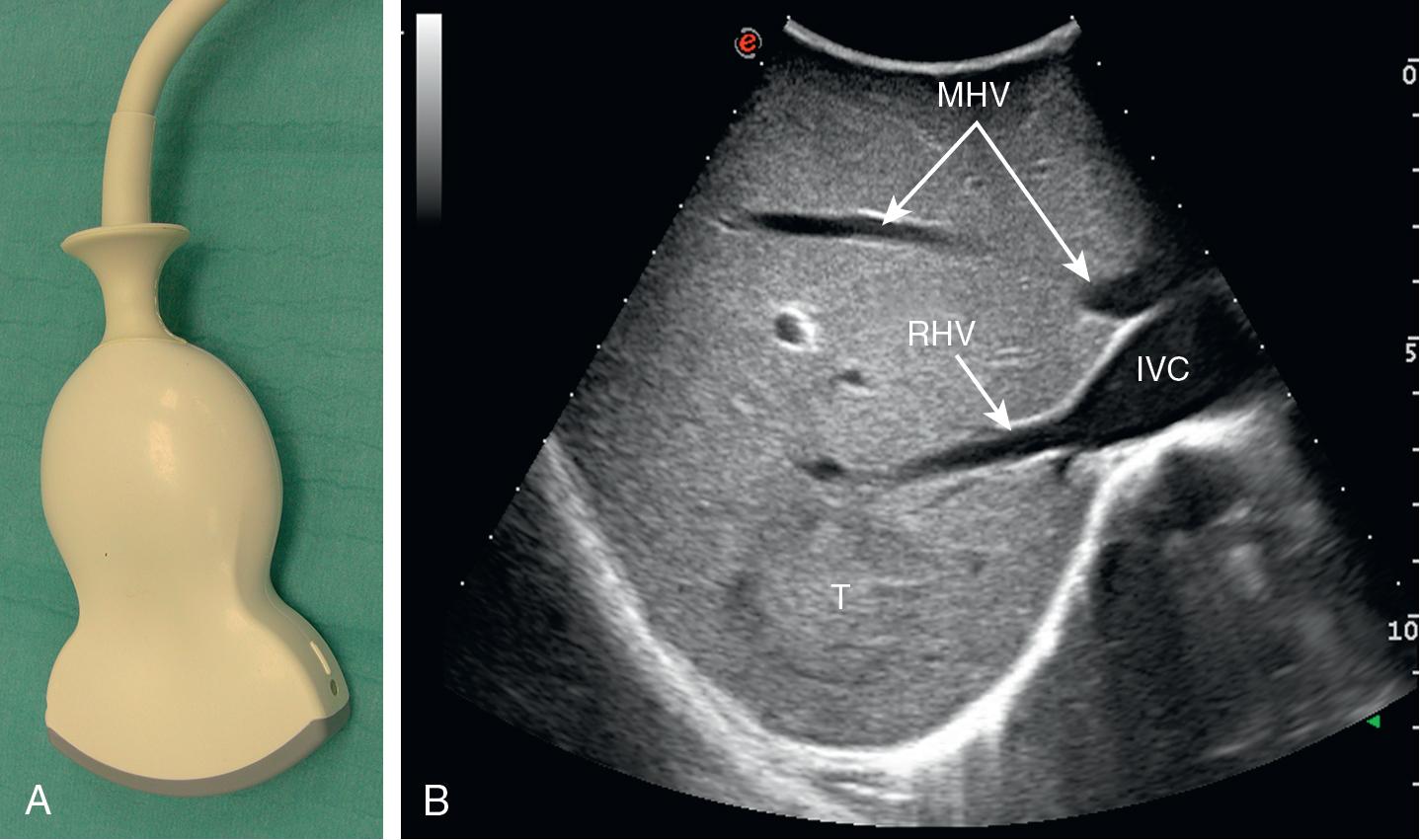
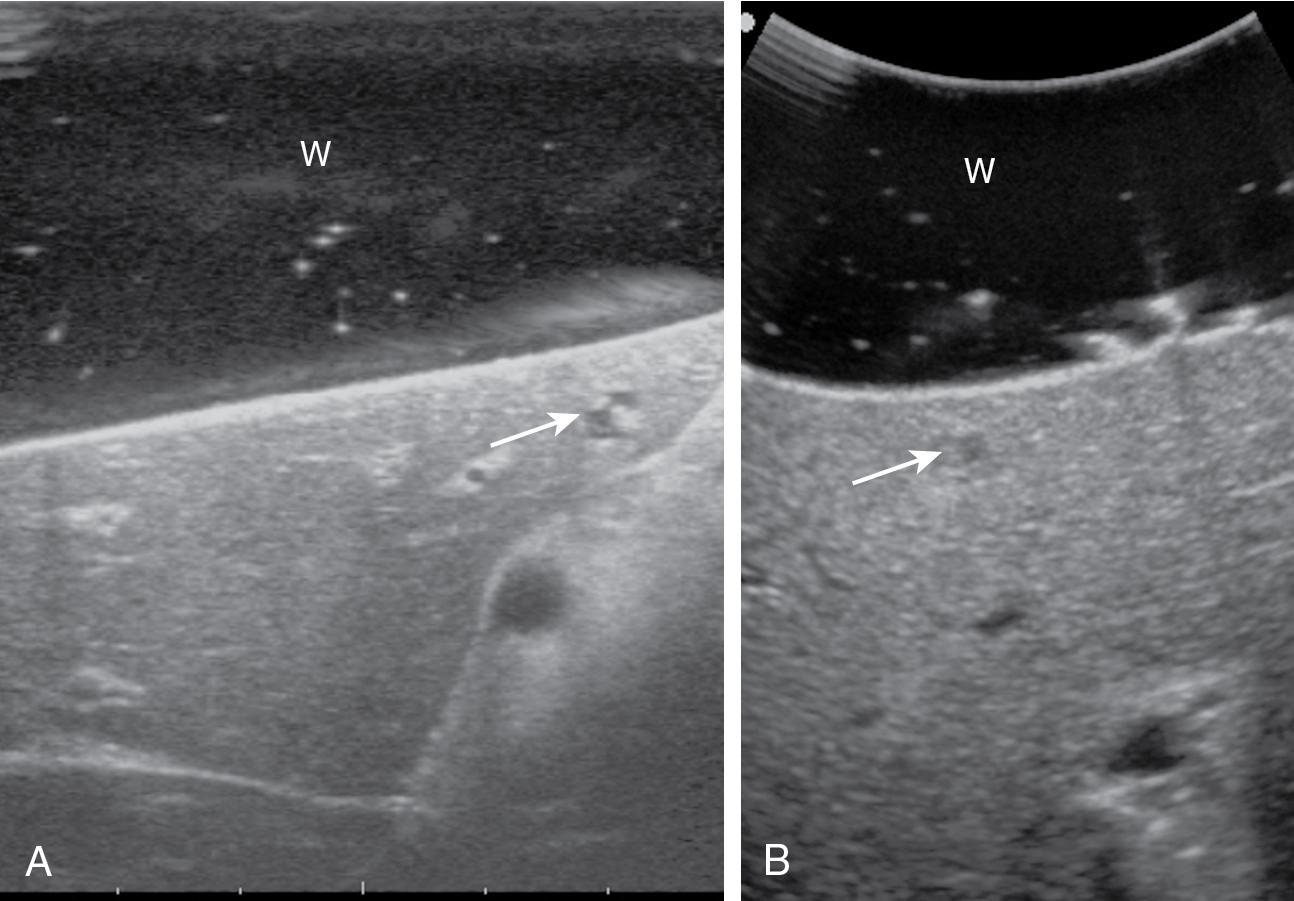
Crucial points to be evaluated when a probe is selected are its shape and volume. Indeed, an optimal probe should represent the best compromise among (1) the size, which should be small enough to facilitate handling in deep and narrow spaces; (2) the US scanning window, which should be large enough to enable the widest area of exploration at once; and (3) the adherence with the surface of the target organ, which should be good enough to enable adequate stability during handling and for avoiding gas interposition and artifacts that may compromise organ exploration.
The most frequently used probes are the T-shaped ( Fig. 103.3 ), interdigital, and microconvex probes ( Fig. 103.4 ). The microconvex probe represents the best compromise among all the previous requirements. Indeed, the T-shaped probe, although it remains more stable and is associated with higher image resolution, has a lower ratio between lateral length and US scanning window than the microconvex probe. More recently, linear transducers with enlarged scanning windows combine the stability of the linear probes and their higher image resolution with larger scanning windows and a limited volume ( Fig. 103.5 ). When probes are evaluated, another aspect that should be considered is the feasibility and ease of use for surgical maneuvers, such as the selective intrahepatic vessel compression mentioned later.
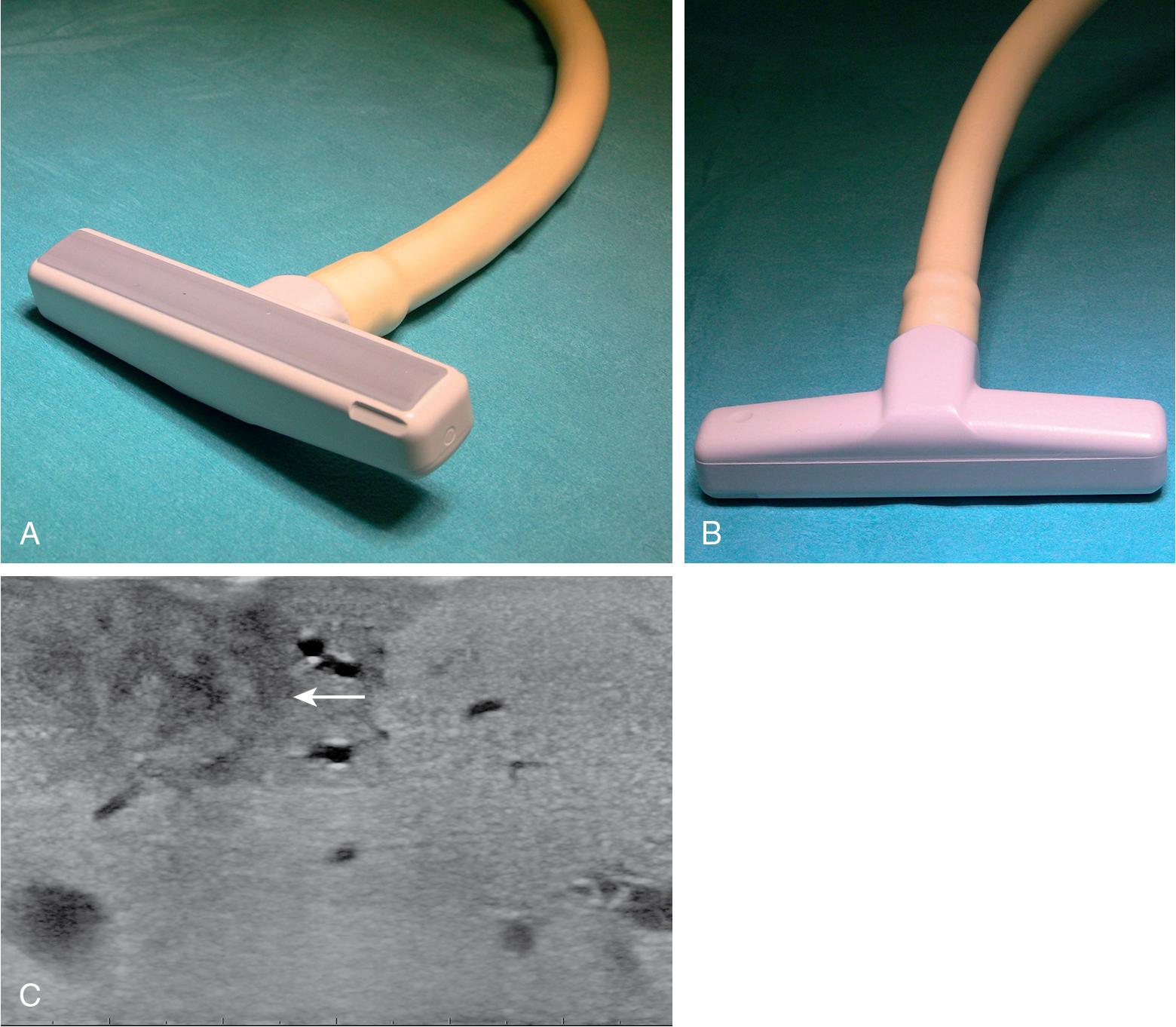
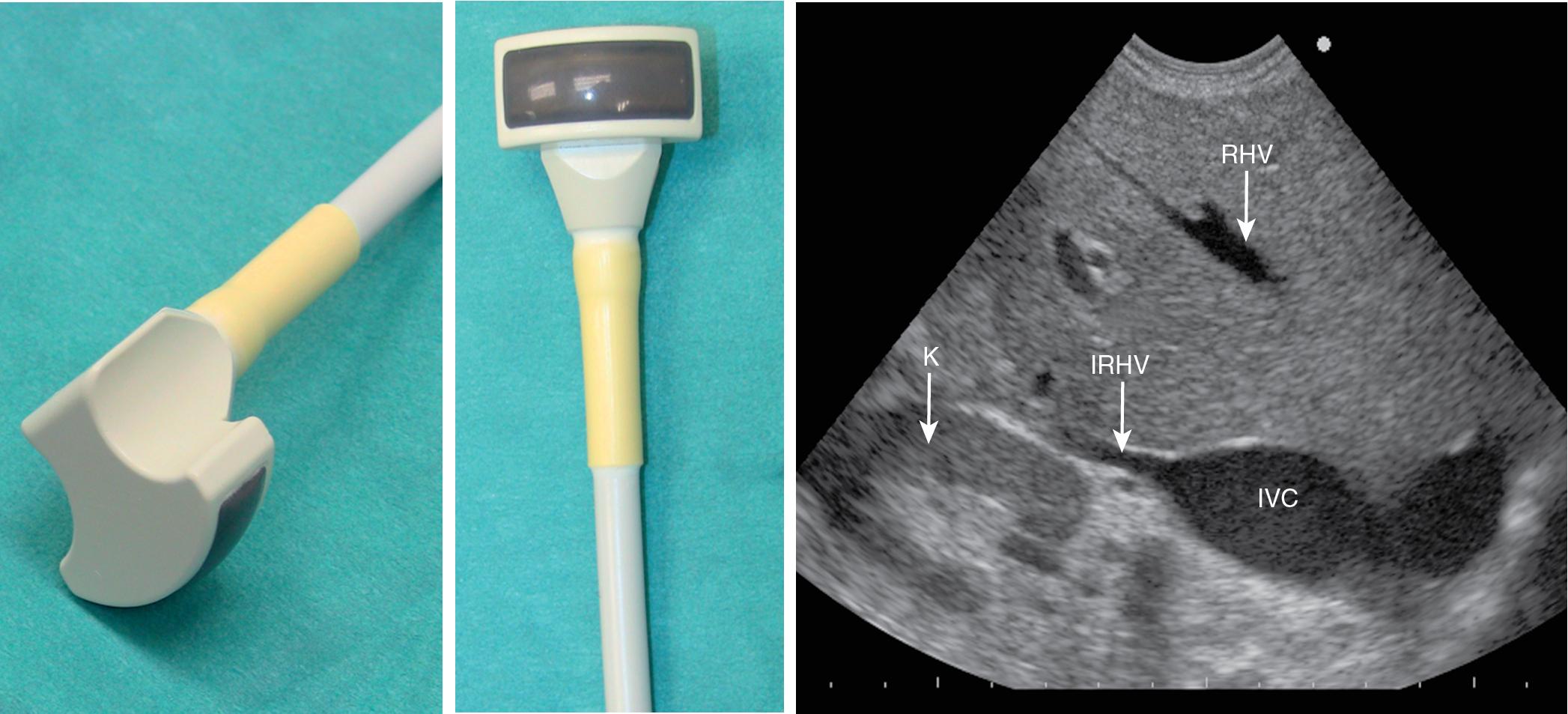
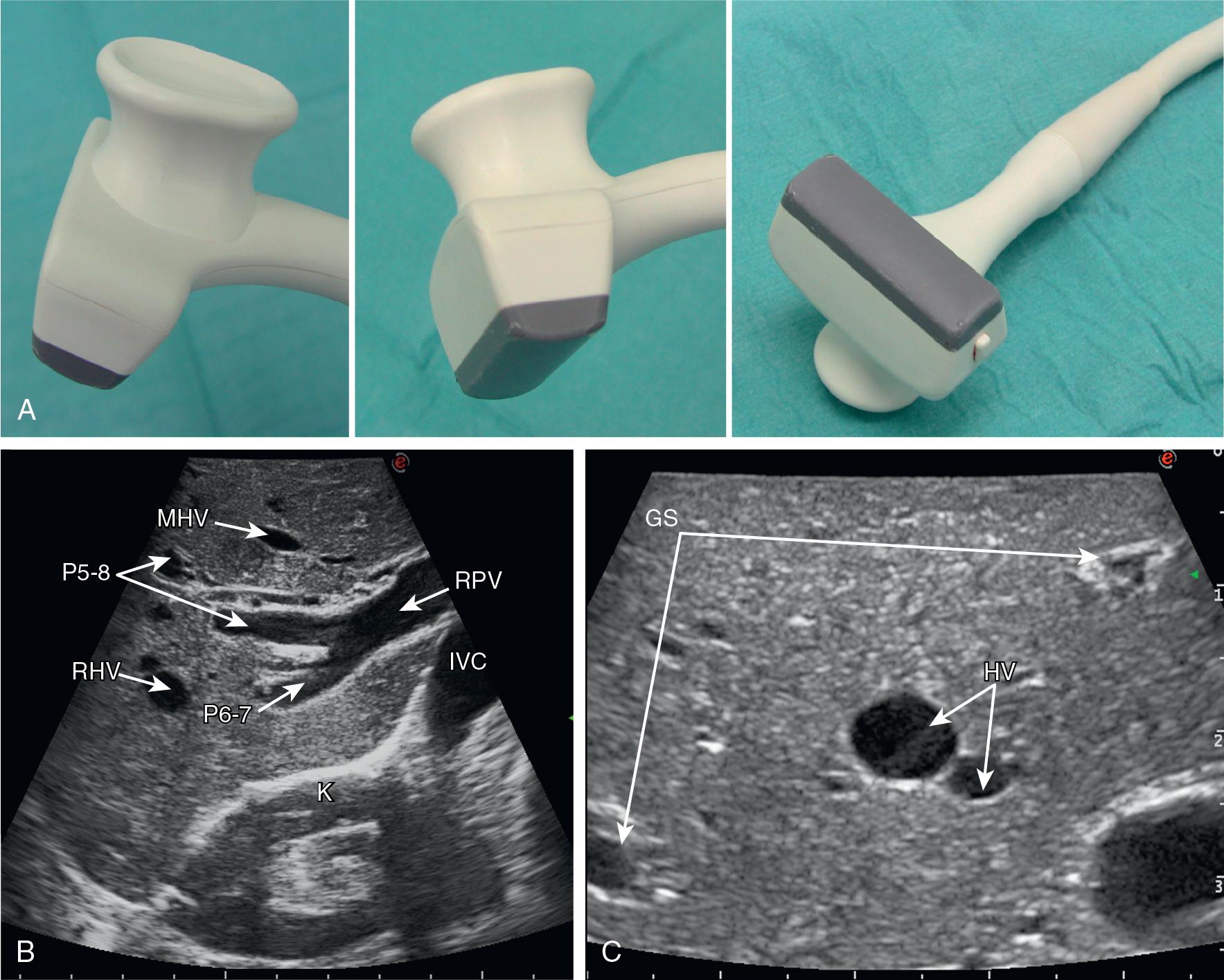
Color Doppler imaging, and particularly more sensitive color-flow modes, have progressively assumed greater roles in the intraoperative evaluation of inflow and outflow of the liver ( Fig. 103.6 ) and assessment of flow modifications during surgical maneuvers. This provides crucial data for allowing surgical strategies that would not otherwise be feasible.
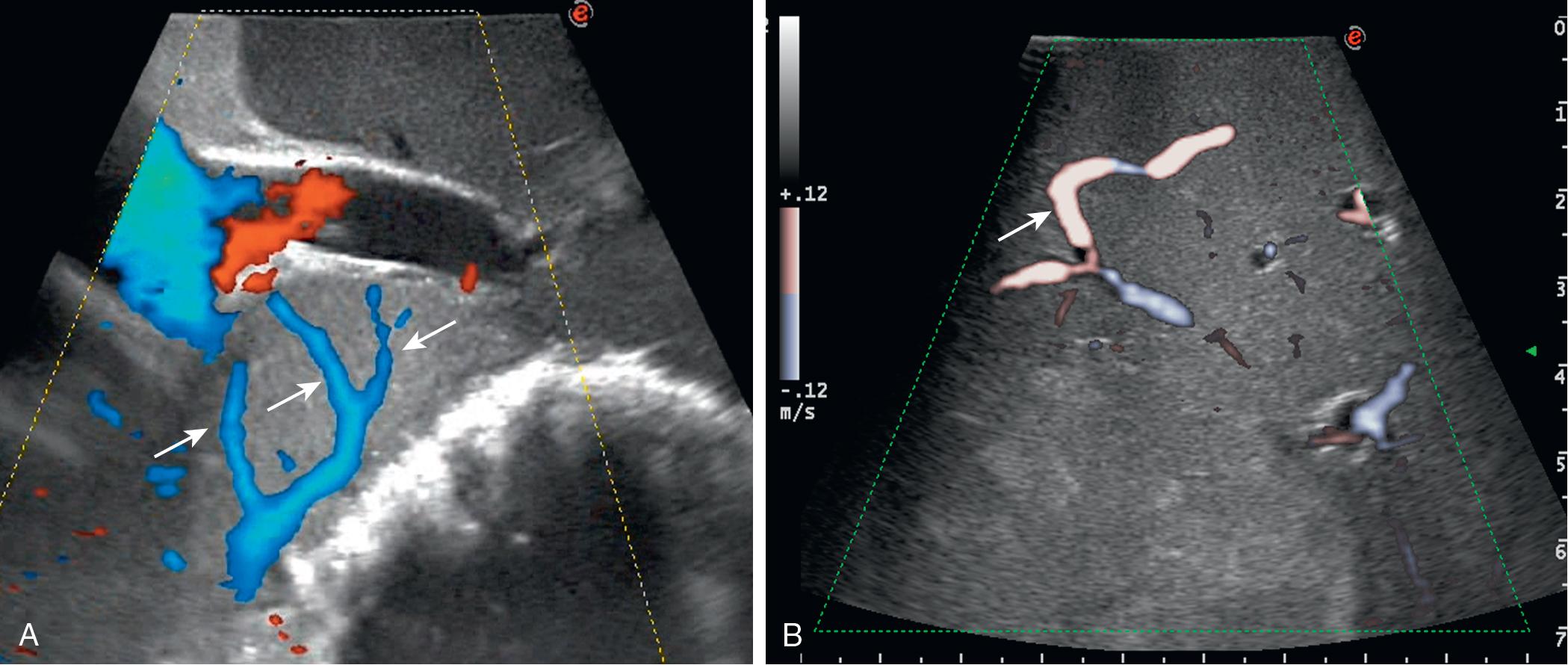
Contrast-enhanced IOUS (CE-IOUS) is now an established application of US and IOUS systems should be equipped accordingly ( Fig. 103.7 ).
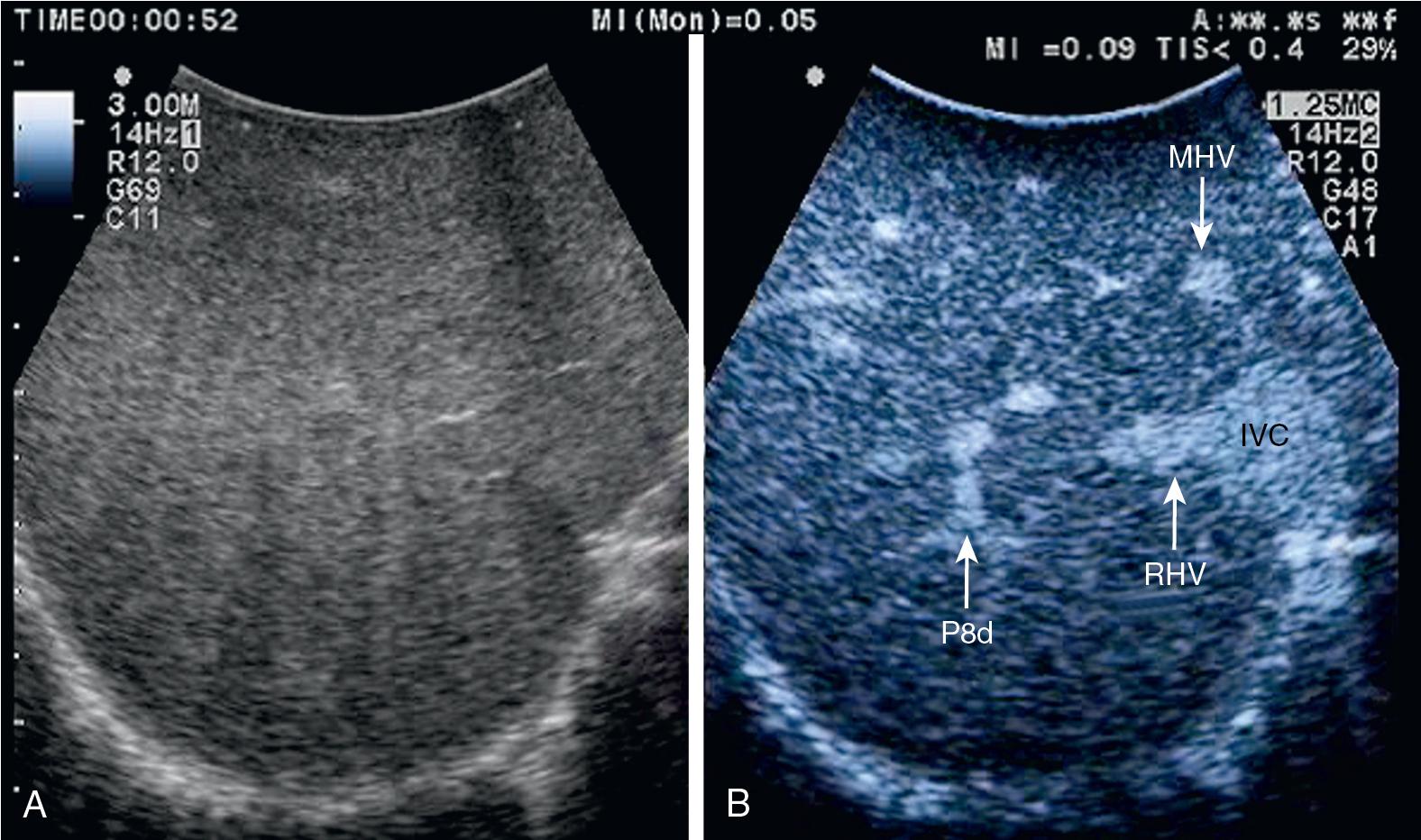
First, it must be stressed that the surgeon in charge of the surgical procedure should carry out the IOUS, rather than assistants, radiologists, or technicians. This is because to provide the most meaningful benefit for the patient and finalization of surgical strategy, the IOUS with US-guided maneuvers and operation should be performed by the same person.
The US system should be positioned opposite to the first operator, who must be able to simultaneously view both the screen and the operative field ( Fig. 103.8 ) unless the operating room (OR) is equipped with multiple screens placed across the surgical field. The screen must be large enough to allow optimal visibility at that distance, and the lights should be positioned with caution not to interfere with the visibility of the US screen. A transparent, sterile covering pad should be available to handle the keyboard directly.
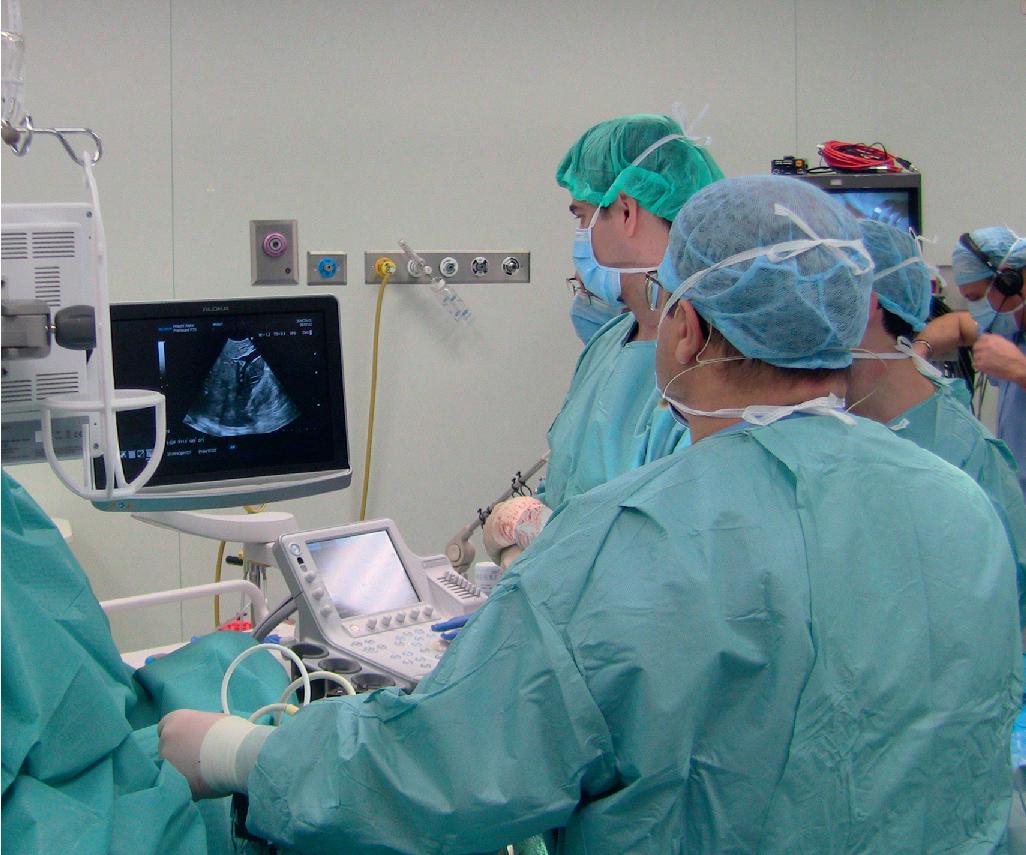
After the abdominal cavity is entered, liver mobilization, division of the round and falciform ligaments, and division of adhesions to free the anterosuperior and inferior surfaces of the liver should be performed before liver exploration with IOUS. Adhesions from the tumor to other organs or structures should not be manipulated because they may represent areas of tumor infiltration; in this situation, IOUS can help by excluding or confirming tumor invasion, which could change the surgical strategy.
For wide exposure of the liver surface, the round ligament can be pulled for traction, allowing tracing of the portal branches and the HVs. The probe should be managed by using enough pressure to ensure good contact with the liver surface but not so much as to compress the intrahepatic vascular structures, particularly the HVs.
Solid knowledge of the liver anatomy is required to perform IOUS properly (see Chapter 2 ). For surgical anatomy, the Brisbane terminology is considered here.
Exploration starts from the Glissonean branches following the portal pedicles at the sectional, segmental, and subsegmental levels, then defining precisely the anatomic location of the IOUS target. Initially, Glissonean pedicles (GPs) can be followed by positioning the probe horizontally, grossly between the cross-margin of segments IV, V, and VIII, to visualize the first order bifurcation ( Fig. 103.9 ). The first-, second-, and third-order Glissonean branches then can be followed in a right-to-left clockwise manner (right GP, right anterior, right posterior, left GP, pedicle to segment IV superior/inferior, segment III, and segment II), just tilting the probe upward and downward, and/or rotating it on its perpendicular axis ( Fig. 103.10 ). Because of the existence of the Glisson capsule, the GPs, which include PV branches, arteries, and bile ducts, have thicker vessel walls compared with the HVs and thus appear at IOUS as echo-free zones surrounded by a thicker, hyperechogenic layer ( Fig. 103.11 A). Furthermore, other parallel, thinner vascular structures are visible, which are the arteries ( Fig. 103.12 ); the bile ducts of the Glissonean triad are also visible ( Fig. 103.13 ). In principle, however, distinction between HVs and portal branches should be based not only on their appearance but also, and mainly, on their anatomy. Indeed, in the cirrhotic liver, as already mentioned, the vessel wall of the HV could be thicker (see Fig. 103.11 B) and not easily differentiated from a peripheral portal branch. Further, cross-sectional scanning could give the wrong impression of two vessels running parallel within a Glissonean sheath, whereas they are the IOUS representation of two branches of an HV scanned just before their confluence (see Fig. 103.5 C).
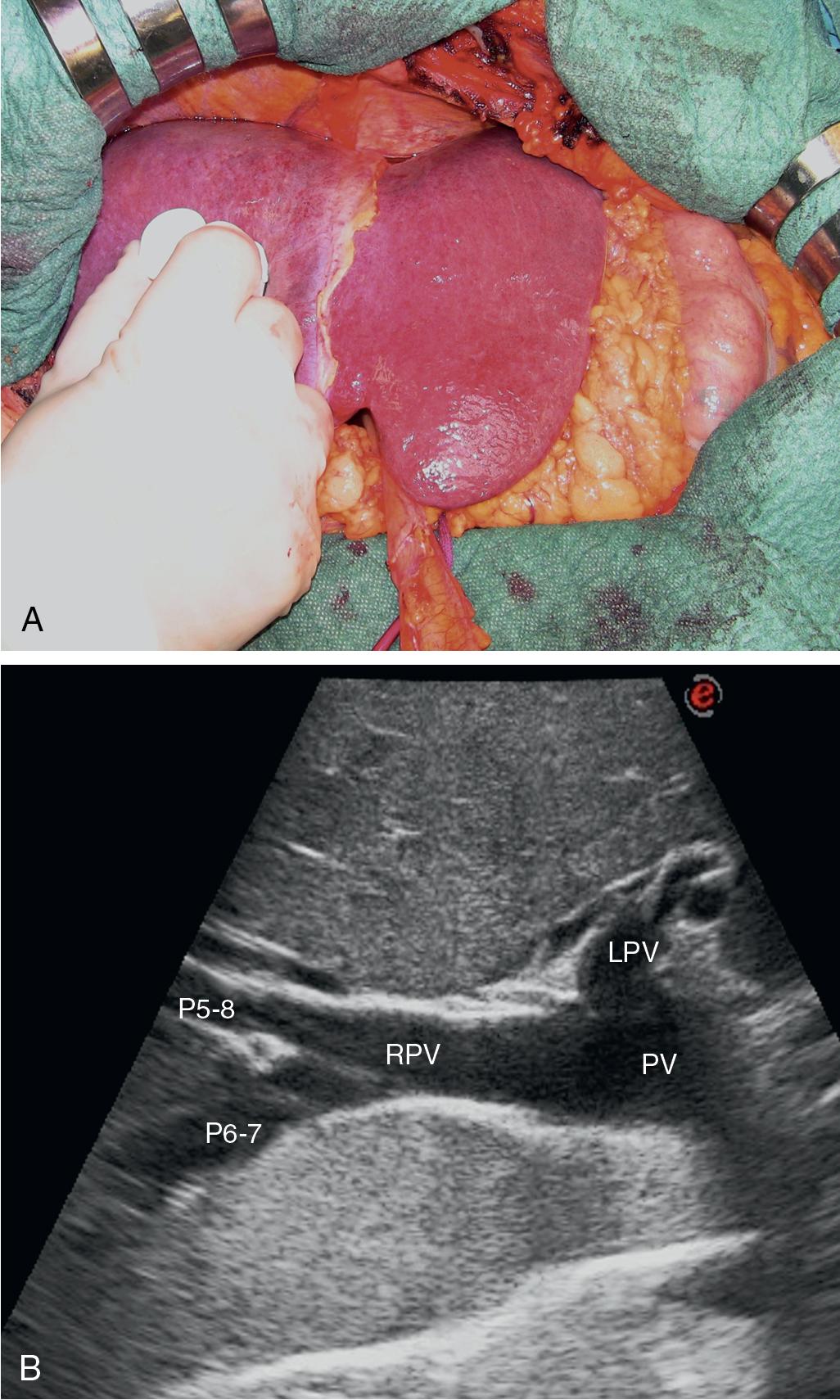
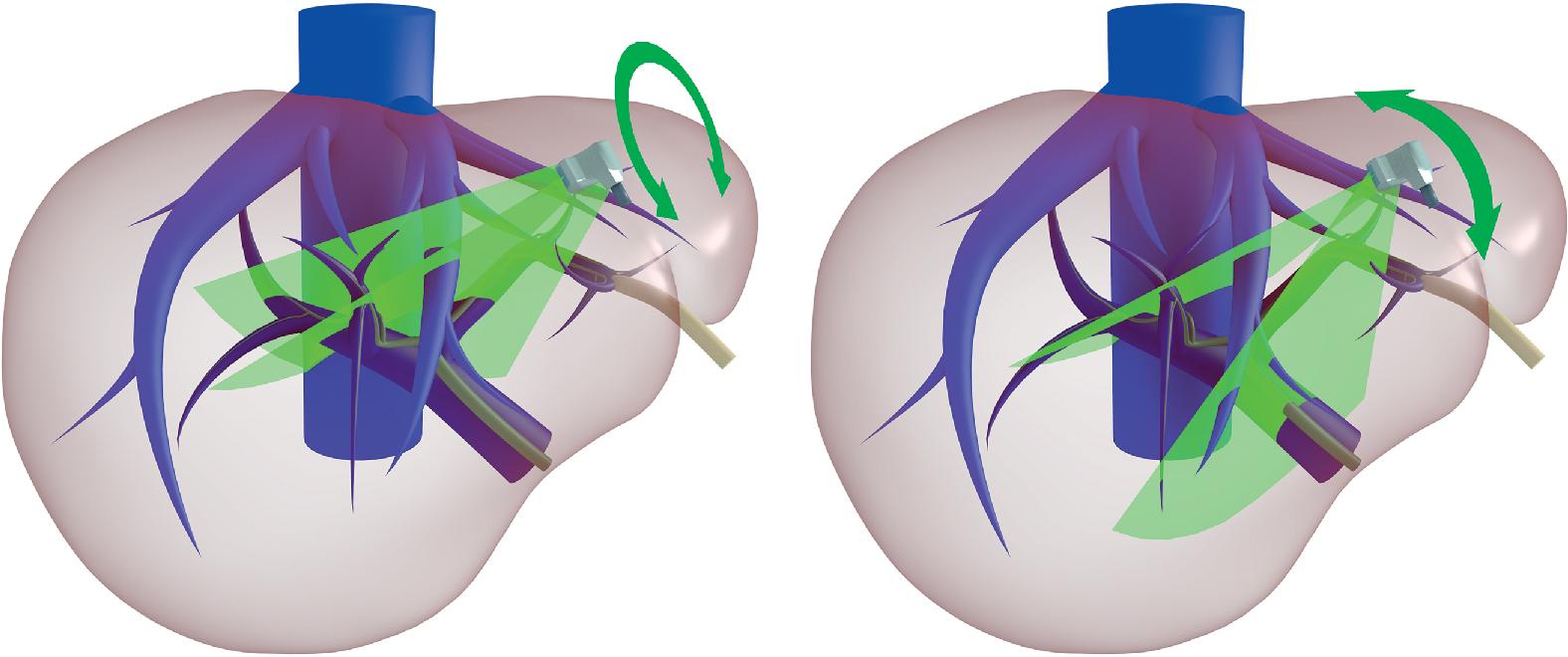
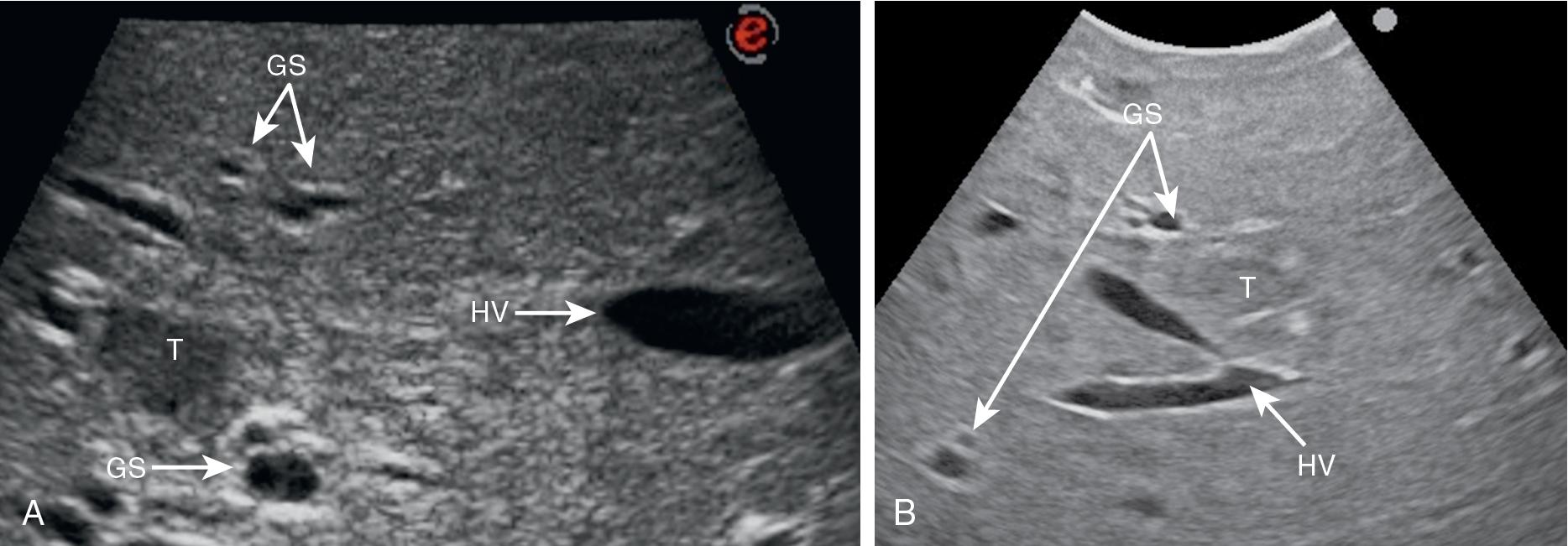
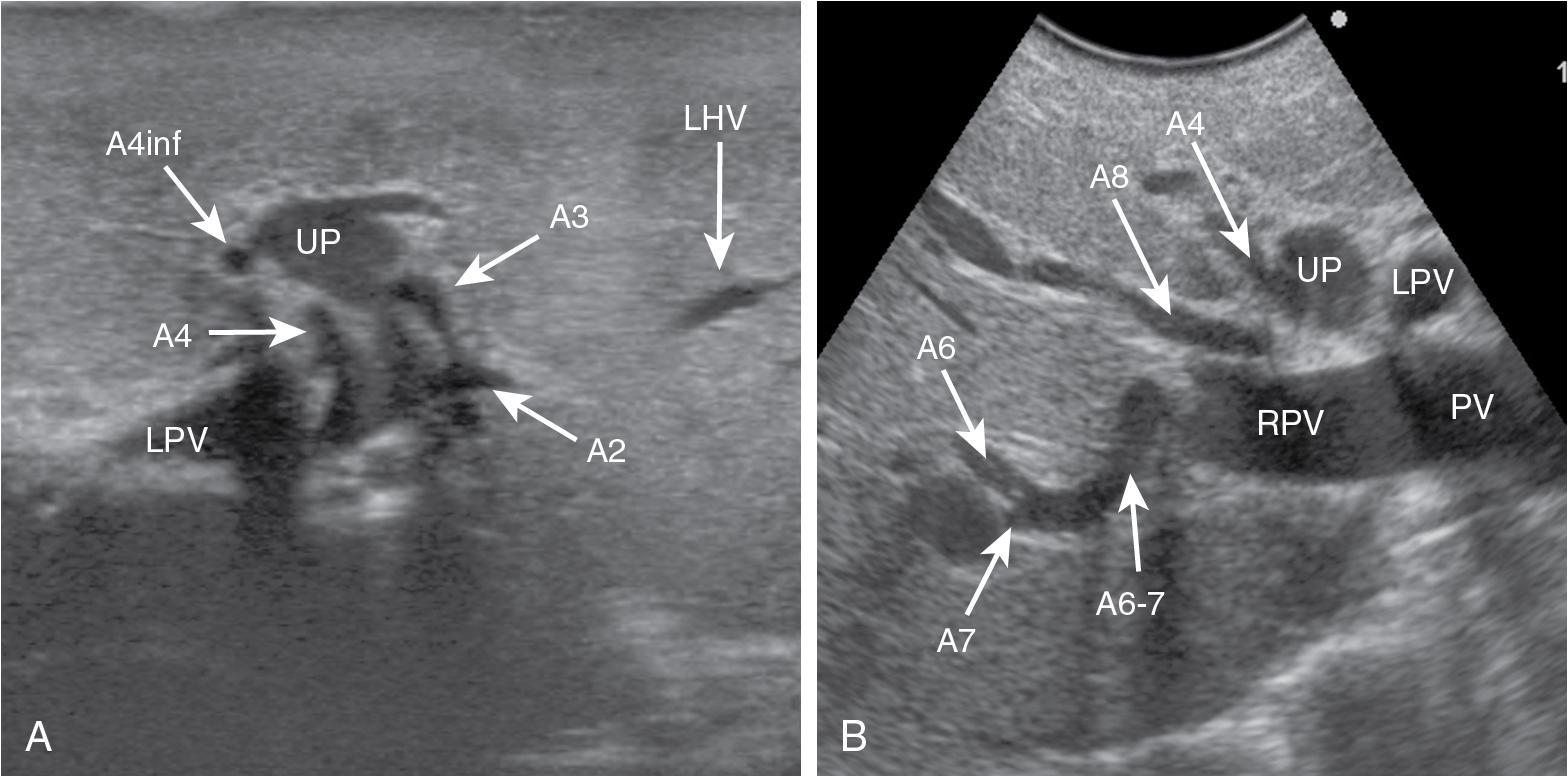
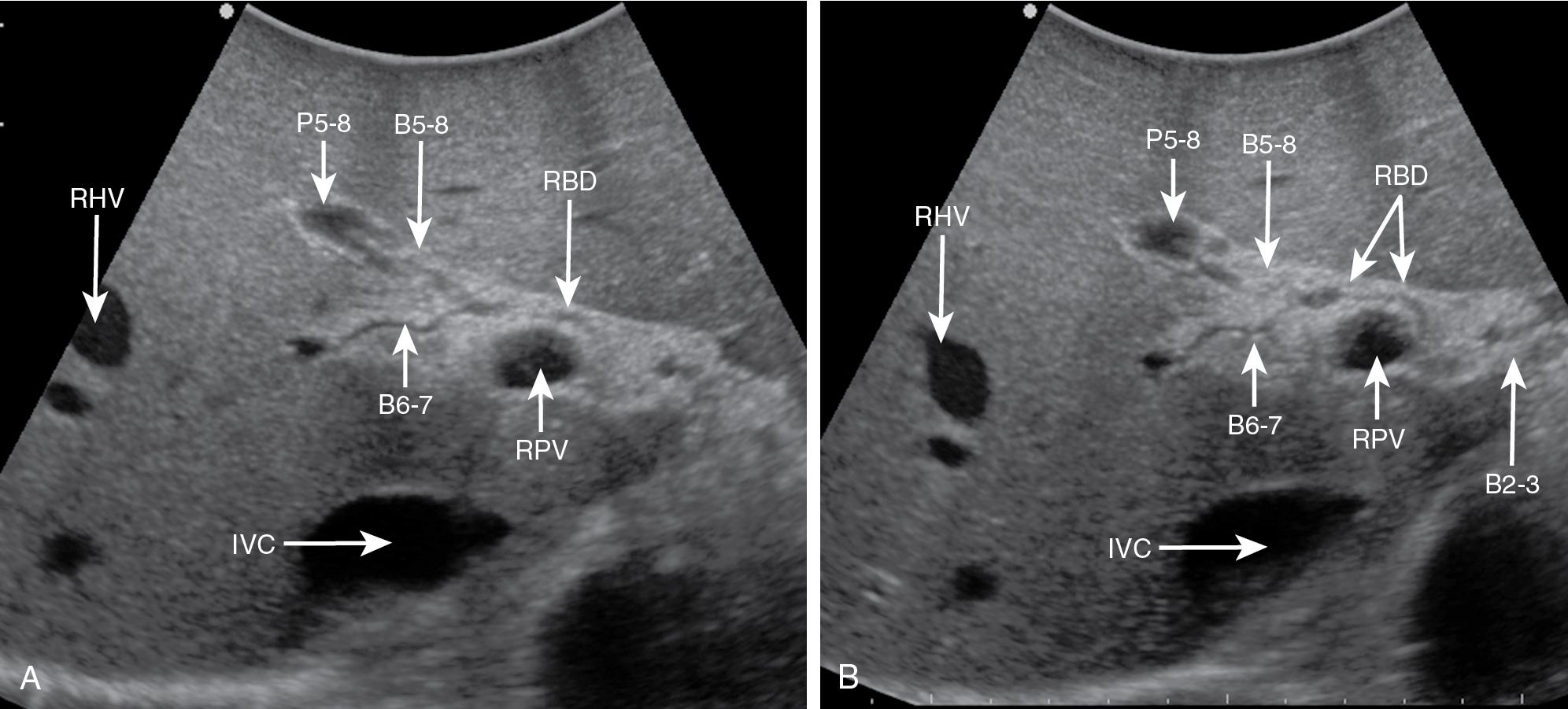
The appearance of the bile ducts on IOUS is worth mentioning because of their peculiarity. Although normally appearing as thin, echo-free zones in the Glissonean triad (see Fig. 103.13 ), once dilated, the bile ducts appear as more evident echo-free zones with a serpiginous path ( Fig. 103.14 ). The element that is difficult to recognize in the IOUS study of the bile ducts is their segmental anatomy; the confluence of sectional and segmental ducts is closer to the hilum compared with the bifurcation of the portal branches ( Fig. 103.15 ). As a result, it is possible to visualize more than one segmental bile duct with one scan, and with enough US background, IOUS can allow exact definition of the bile duct anatomy, not only in pathologic conditions but also in the normal state. This ability also allows for assessment of variations in the normal anatomy, such as confluence of the right posterior sectional bile duct into the left hepatic duct ( Fig. 103.16 ), which is clearly critical information, particularly if a left hepatectomy is planned.
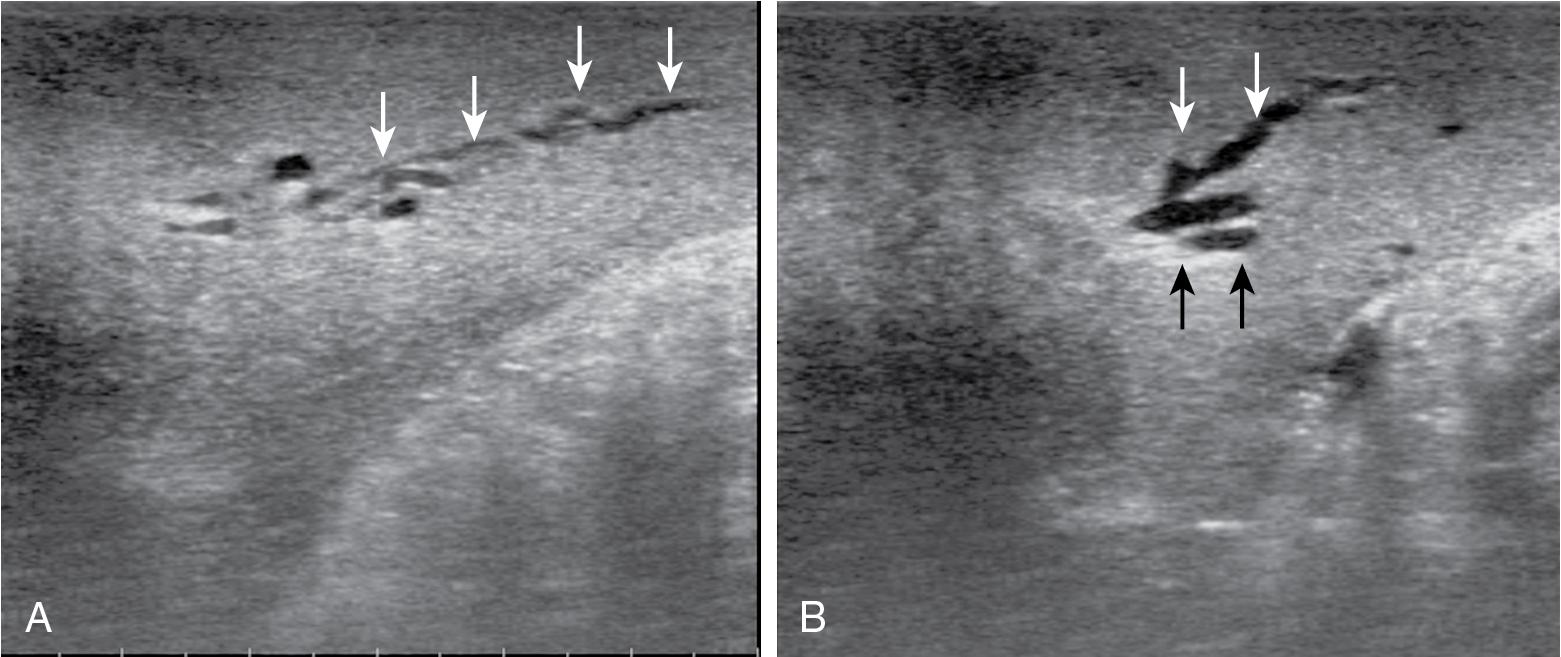
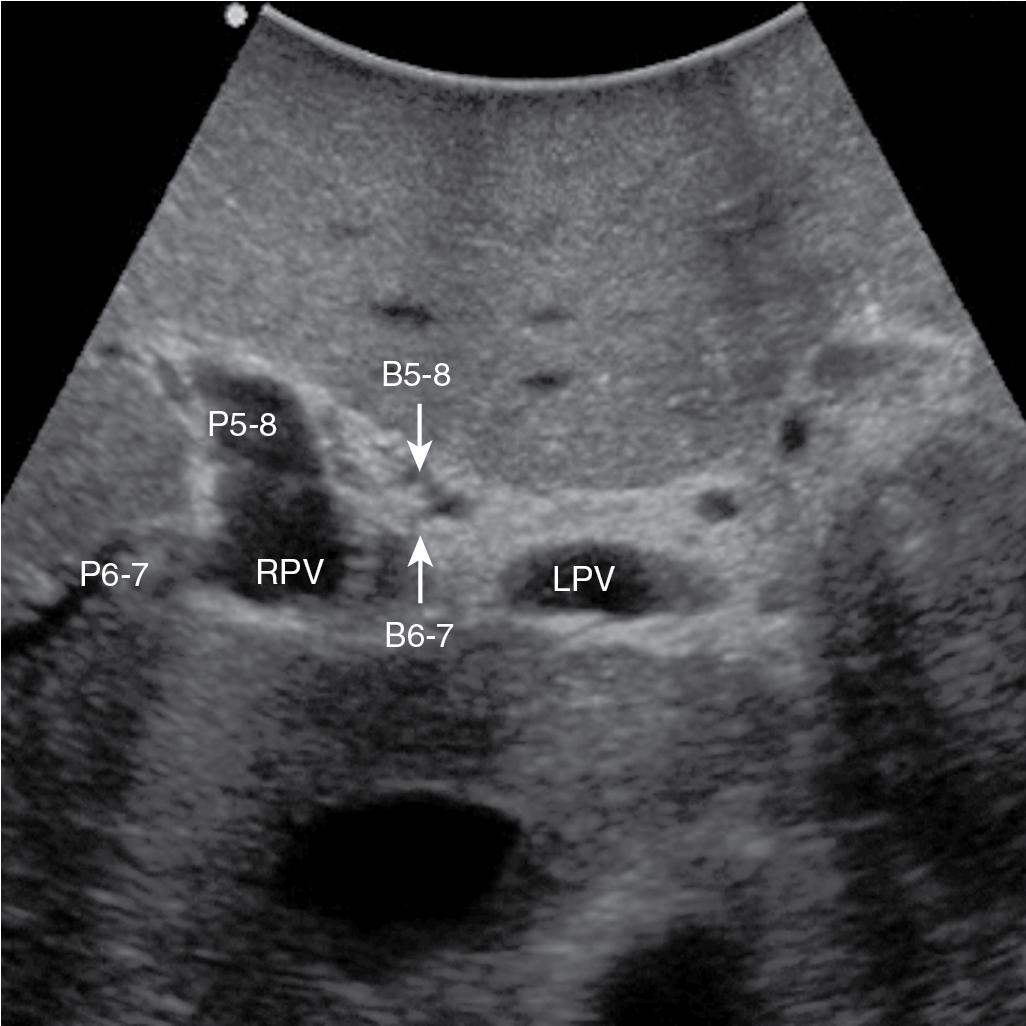
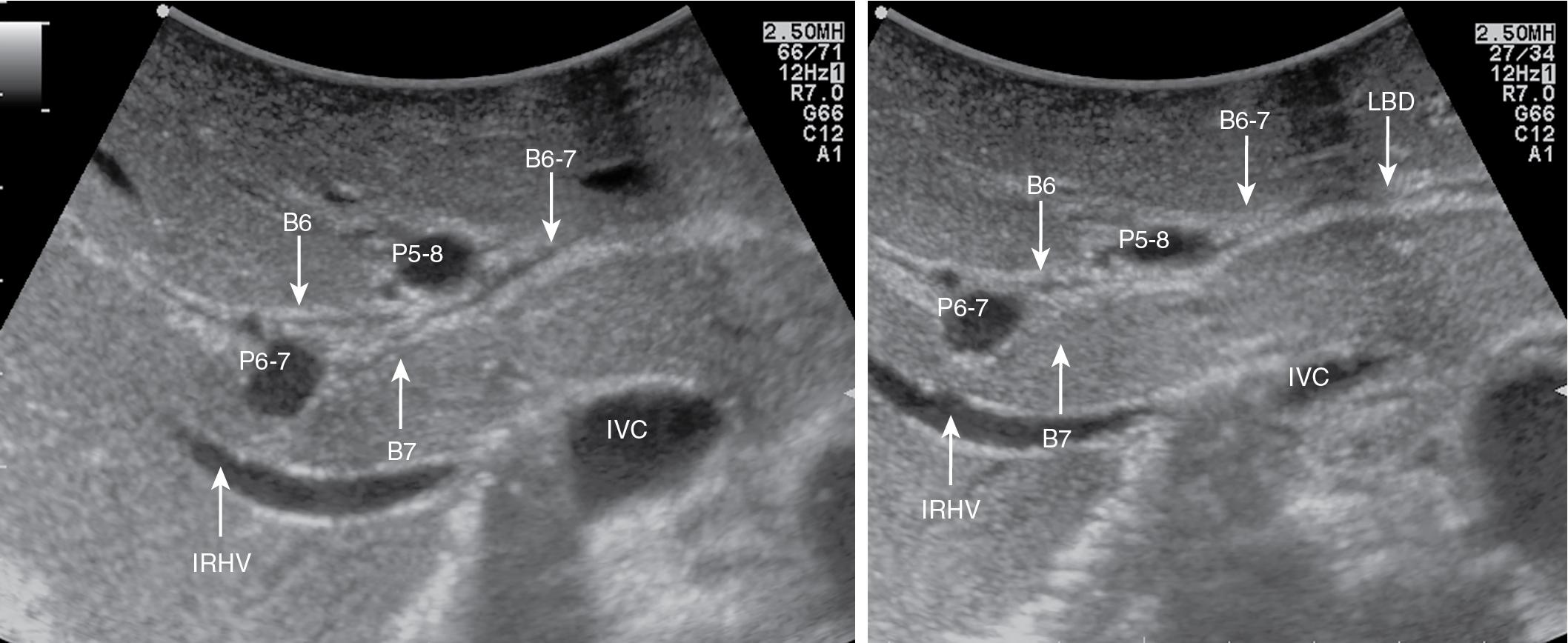
The three main HVs are readily identified at their junction with the inferior vena cava (IVC) as visualized once the portal tree has been entirely explored. The left HV (LHV) appears in between the GPs for segment II and III. Following it upward, the LHV at the hepatocaval confluence is visualized, and when the probe is gently withdrawn, the HV paths can be traced into the liver. As mentioned, HVs appear as echo-free zones in the liver parenchyma, and the vessel wall is invisible or appears as a thin, hyperechogenic line (see Fig. 103.11 A). The walls of HVs can be thicker in the cirrhotic liver, and their lumen can be thinner, as a result of the stiffness of the diseased liver (see Fig. 103.11 B).
Despite the improvement of preoperative imaging, IOUS remains the gold standard for detection and differentiation in liver surgery. Indeed, although palpation still plays a fundamental role, in the case of HCC growing in a cirrhotic liver, or in those patients having had previous liver resection, the firm and irregular hepatic surface makes tumor detection difficult. Up to now, more than 10% of patients have additional intraoperative findings provided by laparoscopic US or IOUS. In the setting of CLM, the problem is sometimes the opposite because with the more efficient systemic treatment extensively used preoperatively, it is not rare to have it assist with the disappearance of some lesions that are anyhow frequently not visible but viable ( see Chapters 15 , 90 , 101 , and 118 ). In this sense, real-time intraoperative fusion imaging could represent a useful tool. Indeed, the possibility to couple in real time the previously uploaded images of the computed tomography (CT) or magnetic resonance imaging (MRI) performed before the systemic therapies with the real-time IOUS scans enables the detailed recognition of the areas in which the disappeared lesions were located ( Fig. 103.17 ).
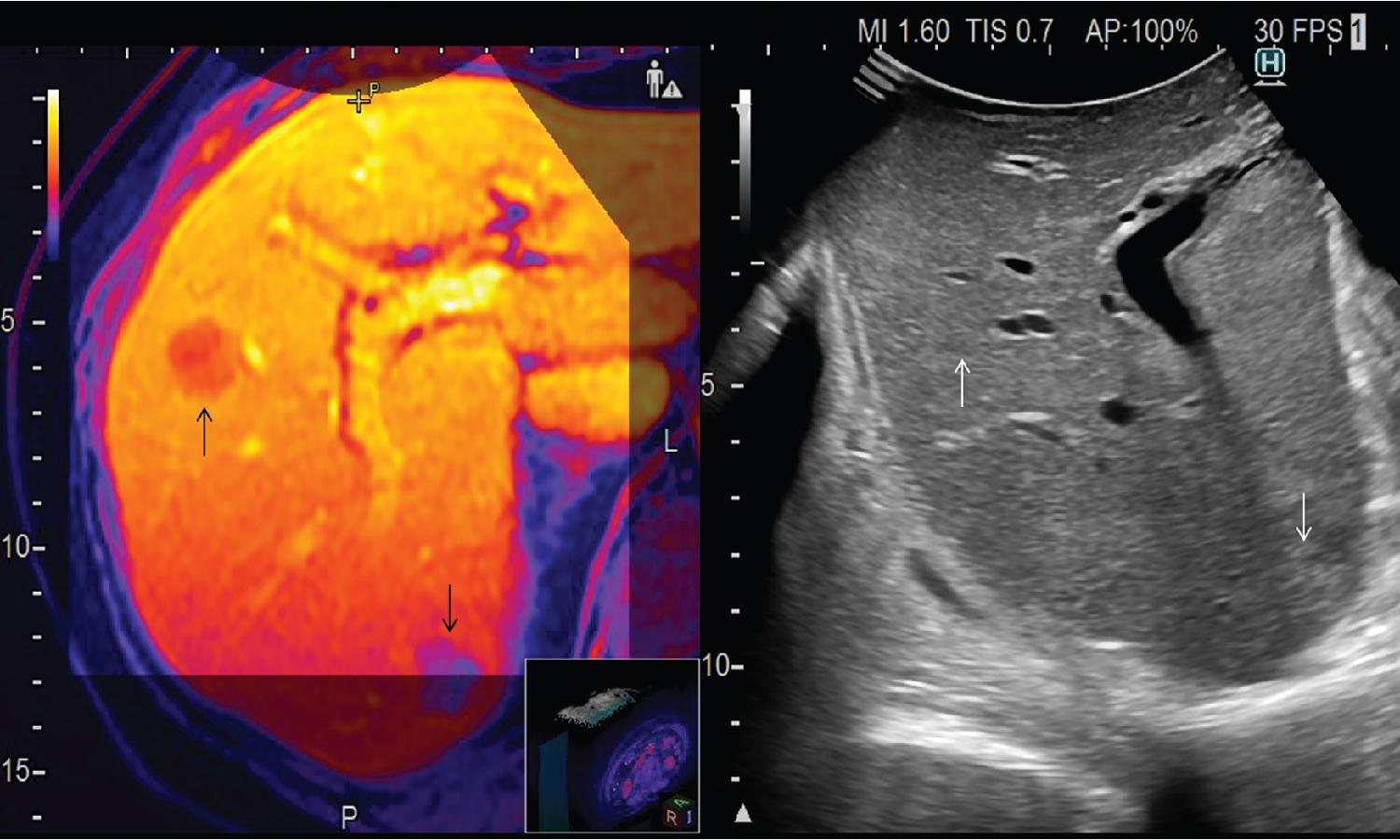
Given all of that, characterization of any new lesion detected intraoperatively remains crucial. The only nodule that can be easily featured at IOUS is the small hemangioma because it displays a typical US pattern, and when compressed, it changes in shape because of its compressibility ( Fig. 103.18 ; see Chapter 14 ). Elastography allowing lesion differentiation based on tissue stiffness expressed on the IOUS screen by different colors may further help in this sense ( Fig. 103.19 ). , Regenerative nodules in cirrhotic patients operated for HCC is a relevant issue for lesion characterization. In this sense, IOUS may risk overestimating the HCC stage ( Fig. 103.20 ). Indeed, except for those nodules with a mosaic pattern evident on US ( Fig. 103.21 A), of which more than 80% are malignant, only the minority are hypoechogenic (dark; see Fig. 103.21 B) and hyperechogenic (bright; see Fig. 103.21 C), meaning they are neoplastic. , CE-IOUS as described in the next paragraph plays a relevant role in the nodule differentiation and detection.
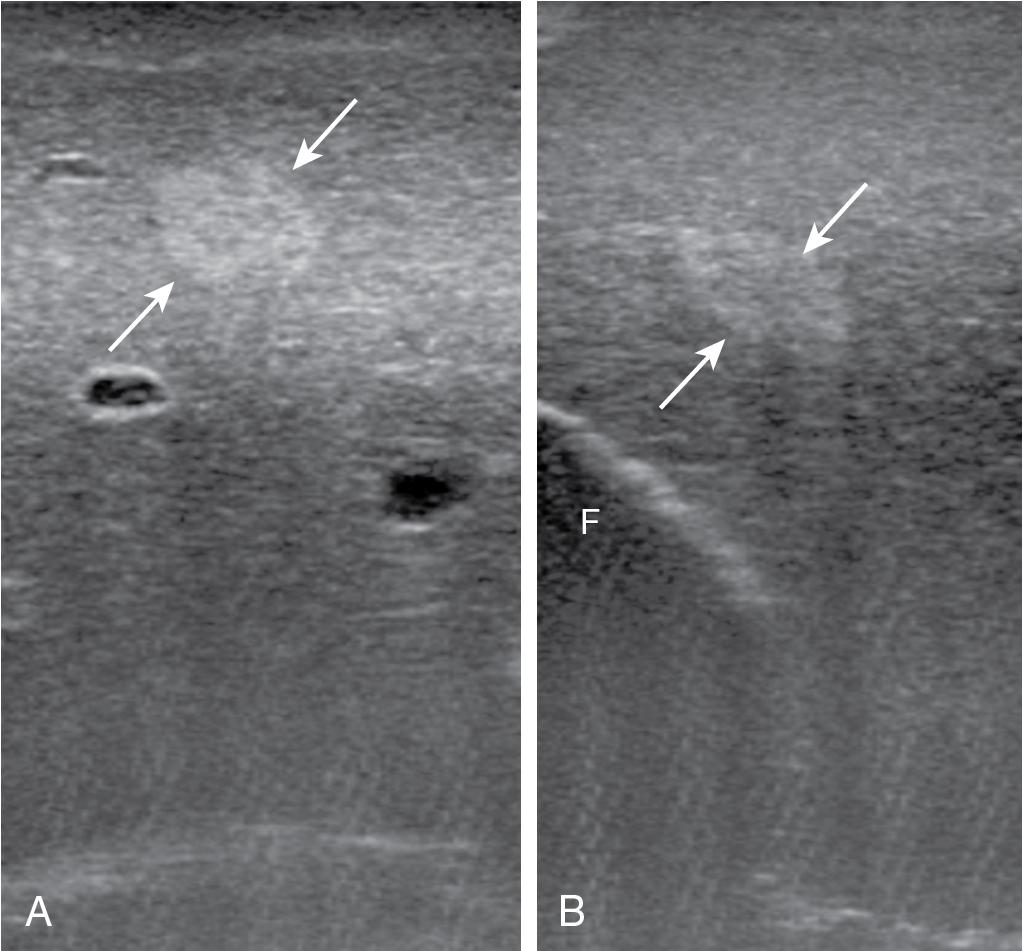
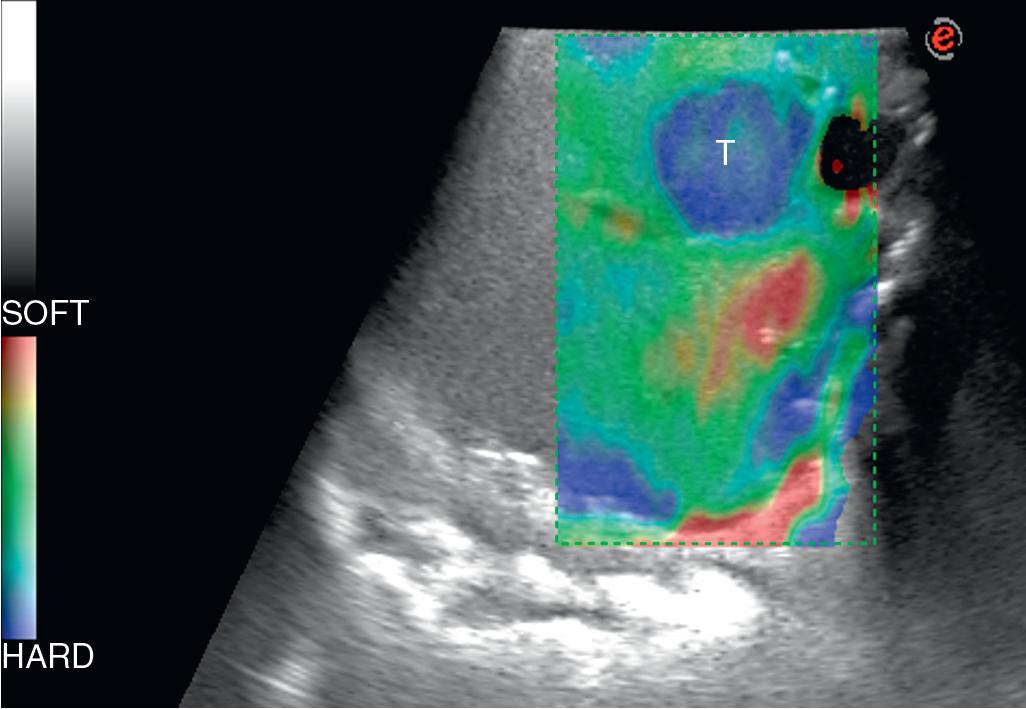
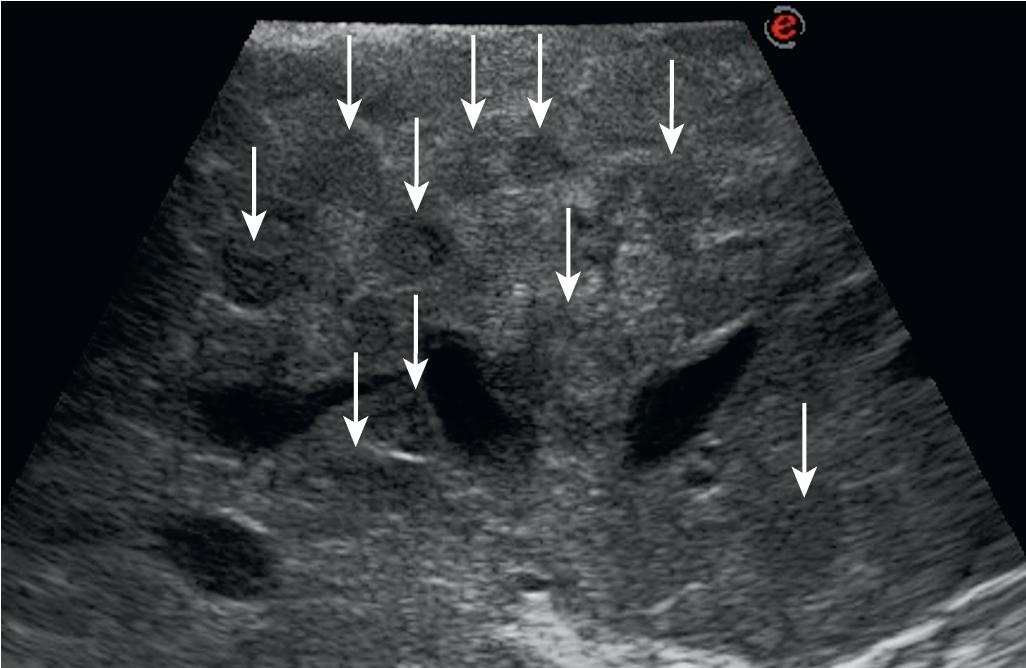
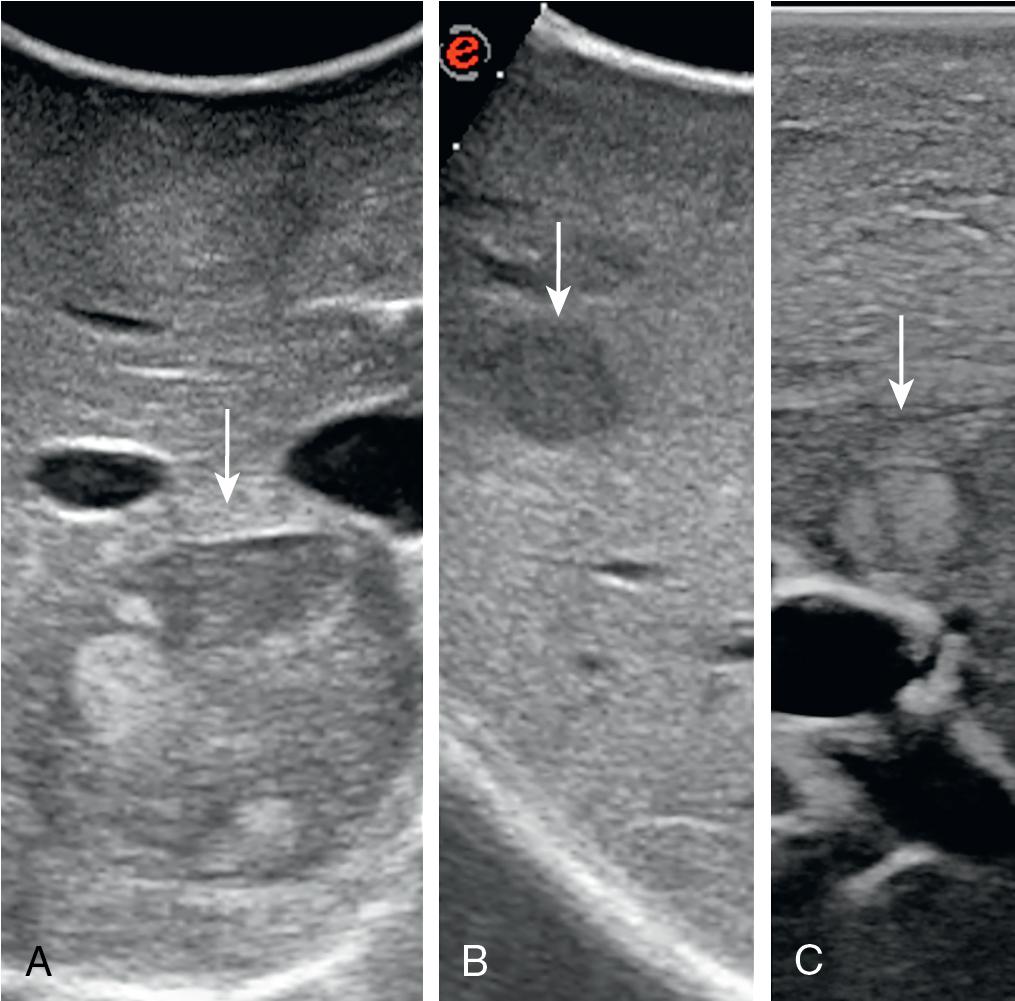
In 2004 CE-IOUS was introduced (see Fig. 103.7 ) both for characterization and detection of liver lesions (see Chapters 14 , 15 , and 24 ). Since then, several studies with different contrast agents have shown that CE-IOUS enhances tumor detection, despite the progress of preoperative imaging and preventive IOUS exploration. It has been feasible to differentiate between HCC and a dysplastic nodule-using vascular contrast agent such as Sonovue. A classification of the enhancement pattern of lesions seen at CE-IOUS has been established, upon which the surgical decision making is established ( Fig. 103.22 ). In brief, any pathologic lesion will appear as hypoechogenic at the late phases, with or without full enhancement ( Fig. 103.23 ) or inner vascularity ( Fig. 103.24 ) during the arterial phase, and should be removed. More recently, using a vascular and postvascular contrast agent (Sonazoid), patterns of enhancements seem linked to the overall and recurrence-free survival and even to some gene expression profiling featured by poorer prognosis.
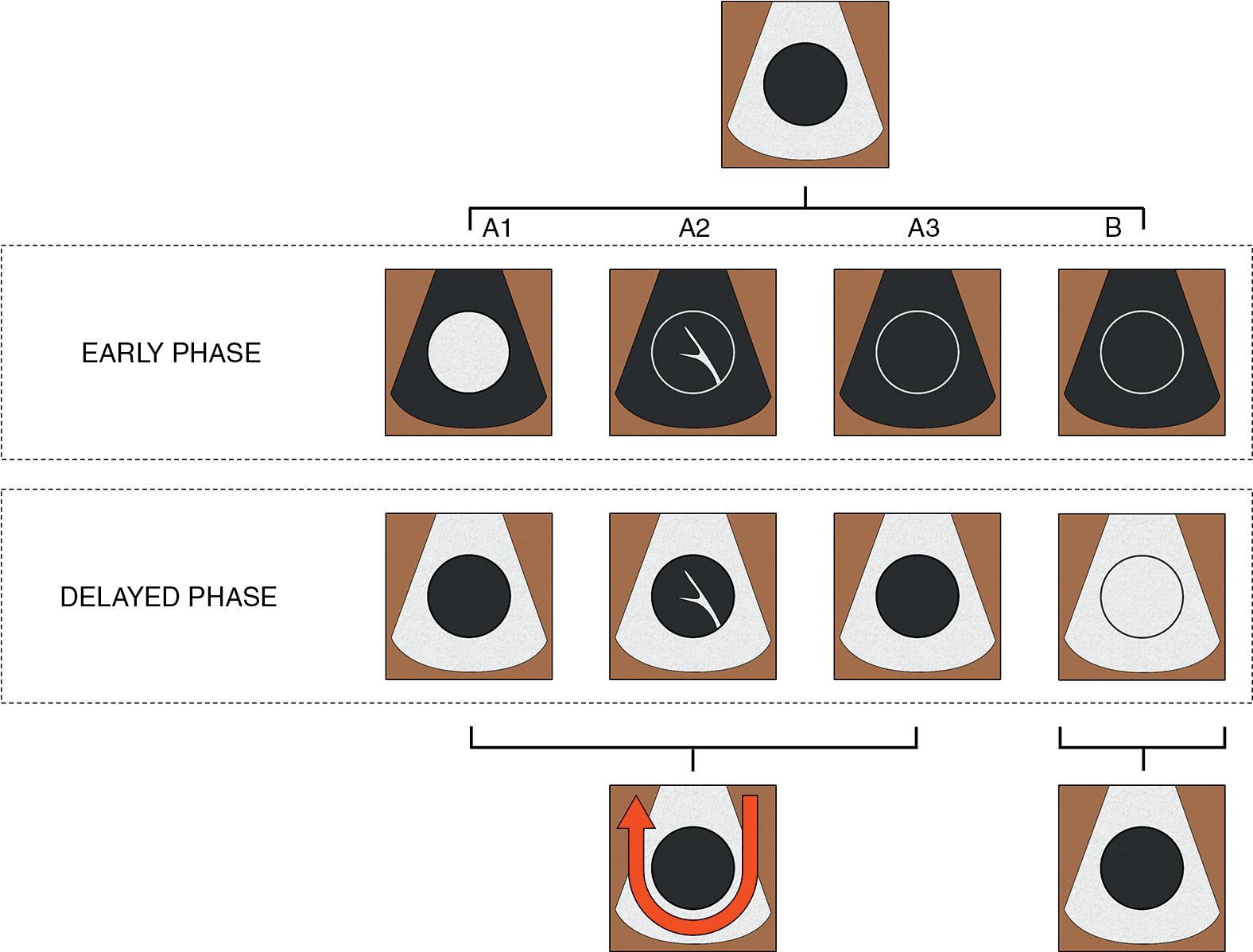

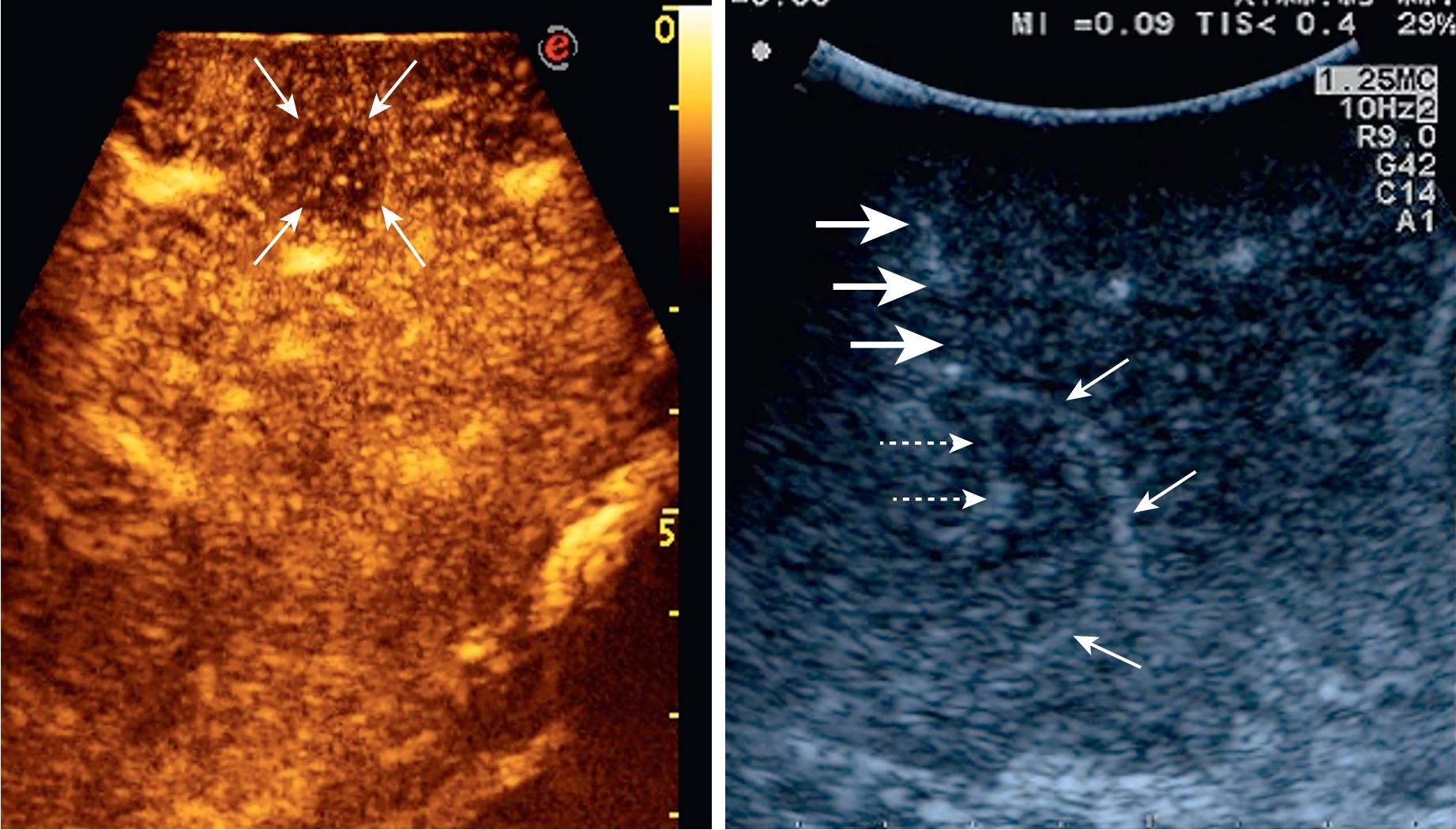
Using Sonovue, the improvement of the detection of CLM in all patients undergoing liver resection, which was initially sustained, , , have been further confirmed. Indeed, CLM, in the late phase, which lasts from 2 to 5 minutes after injection, remains unenhanced and black in comparison with the surrounding enhanced liver parenchyma: the so-called “black-hole effect” ( Fig. 103.25 ). Thankfully, CE-IOUS has allowed us to detect 9% additional nodules in our experience. This increment in sensitivity appears to have particular relevance in the absence of a bright liver and in the presence of multiple isoechoic CLM: these last conditions represent those with the higher risk of missed lesions with simple IOUS ( Fig. 103.26 ). In contrast, for those presenting with hypoechoic CLM in a bright liver, visibility is generally optimal on IOUS ( Fig. 103.27 ). Also, CE-IOUS with Sonazoid proved to increase CLM detectability. Both Sonovue and Sonazoid appear to increase the detectability of those CLM that disappeared after chemotherapy at preoperative imaging, , despite the improvement of the preoperative imaging with the advent of liver-specific MRI contrast agents. CE-IOUS and hepatospecific MRI are rather complementary; a recent analysis has shown that CLM disappearance both at preoperative hepatospecific MRI and Sonazoid is associated with a high probability of CLM having truly disappeared.
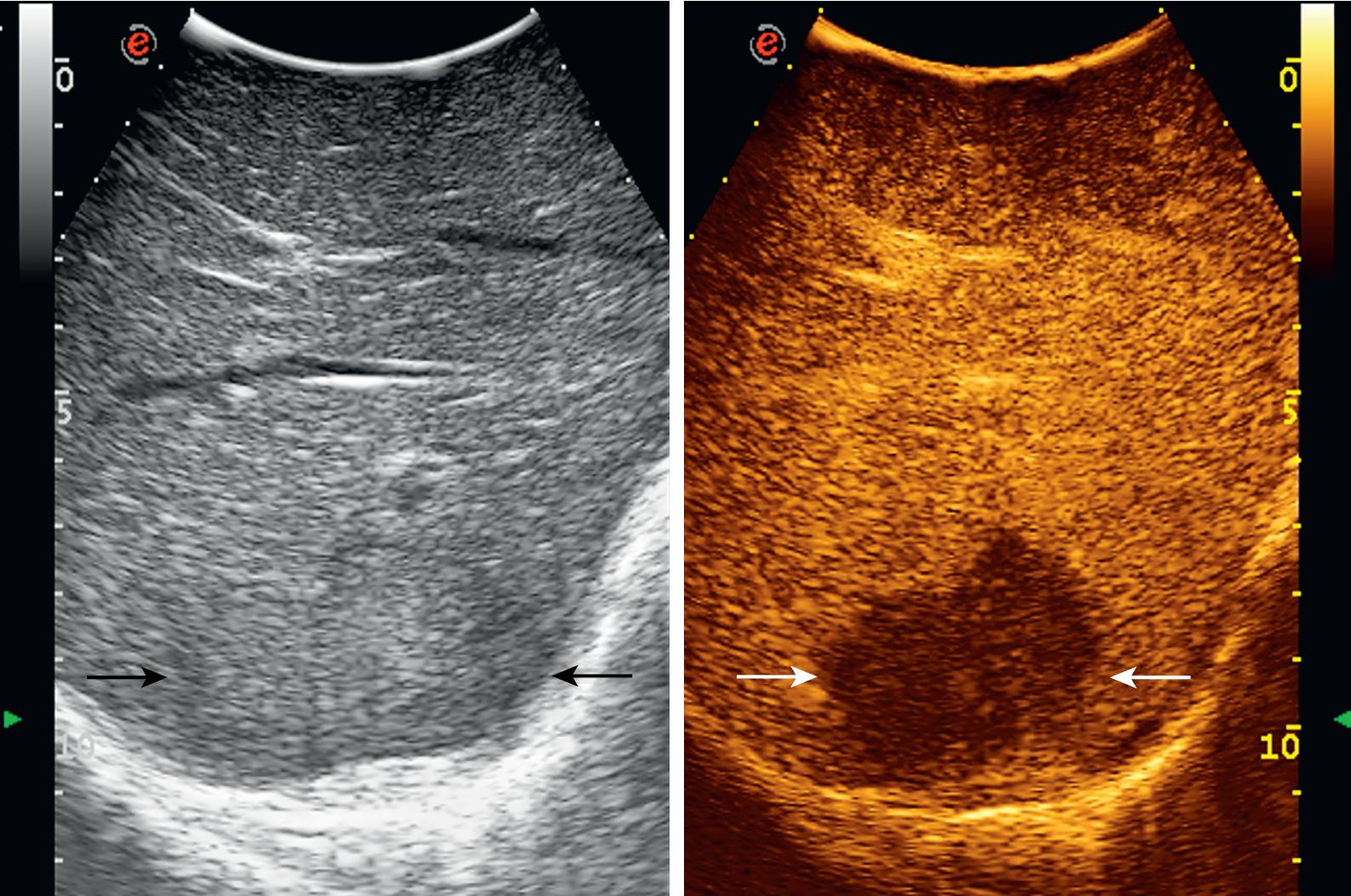
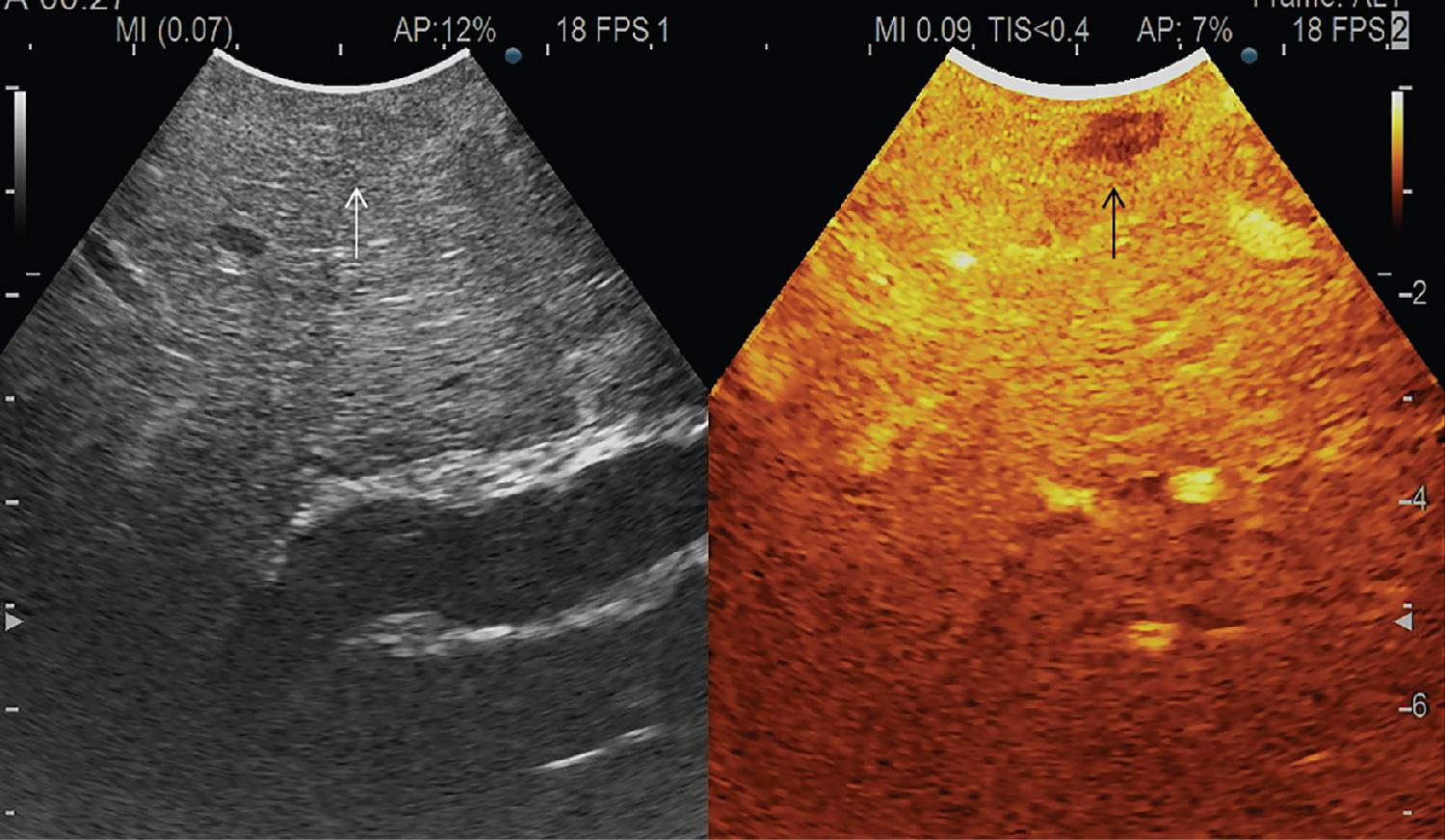
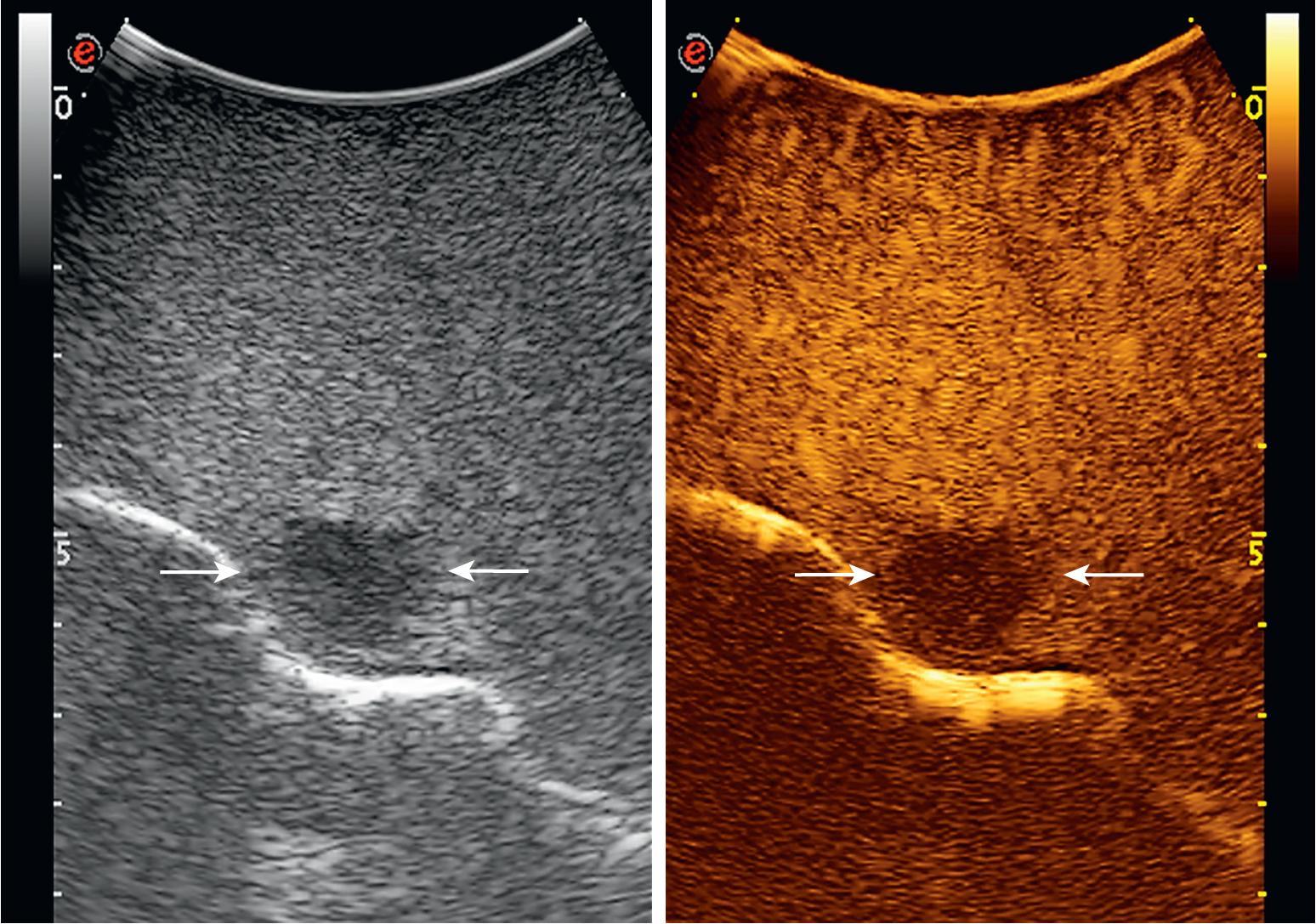
Caution should be used in patients with CLM who have coexisting liver cysts, which may appear like the CLM along the delayed phases of contrast enhancement. However, the cysts should have been already mapped based on the preoperative imaging and identified at exploration with conventional IOUS. Although liver cysts at unenhanced IOUS have an anechoic content and a posterior echo ( Fig. 103.28 ), however, tiny CLMs can also assume a hypoechoic pattern with posterior echo mimicking that of small cysts ( Fig. 103.29 ). Therefore any new black hole detected in the liver in locations where no cysts were detected should be considered suspicious for malignancy (see Chapters 14 , 15 , and 24 ).
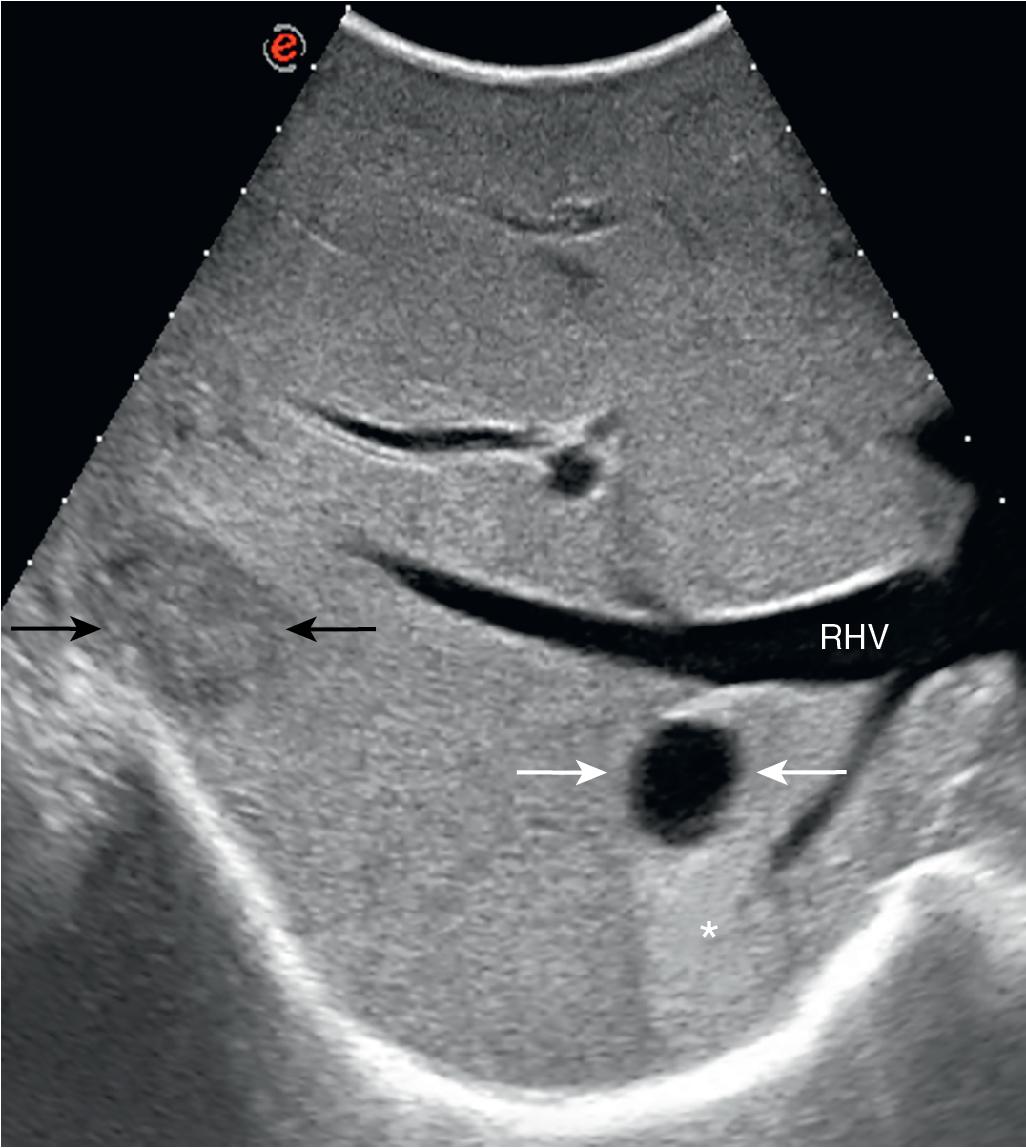
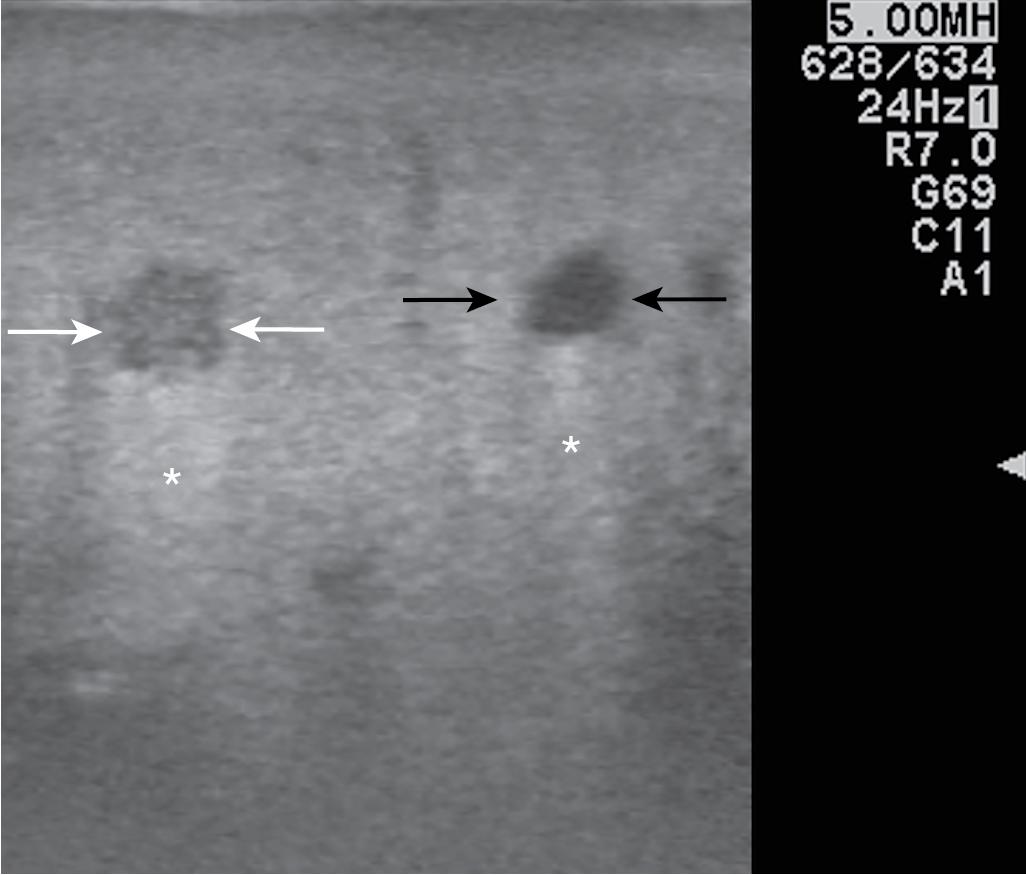
The impact of CE-IOUS in modifying the surgical strategy is strongly influenced by the attitude of the surgeons. Given the capability of CE-IOUS to improve tumor detection, for the liver clearance, the confirmation of the predicted strategy depends on the possibility of including the new lesions within the planned resection area; this is often a subjective decision based on surgical attitude and expertise. Then, despite new findings by CE-IOUS, it is not obvious to assist in a modified surgery; however, this element, being basically subjective, does not diminish the value of this specific diagnostic tool.
Still, concerning the resection guidance, CE-IOUS has provided some additional tricks to the surgeon for improving technical performances, such as the intraparenchymal profiling of the liver segments using Sonazoid, which aids in resection of HCC in an anatomic fashion.
From a technical standpoint, as mentioned, visual effects could last up to 5 minutes after injection, which can be repeated for global reassessment, or to assess the arterial phase enhancement of identified lesions for their characterization. With vascular and postvascular phase agents, detection of malignant lesions can appear up to 20 to 25 minutes post-injection in the hepatospecific phase. , , , Irrespective of the contrast agent used, high doses should be avoided because this limits US penetration in all phases.
These resections are performed by following exactly the planes that divide hemilivers, sections, segments, and subsegments (see Chapters 101 and 118 ). Technical requirements for accomplishing truly anatomic sectionectomies and formal major hepatectomies are uniformly accepted and could be divided into two modalities: one based on the dissection of the vascular elements at hepatic hilum and one based on blunt encirclement from the hepatic hilum of the hemiliver or sectional pedicles. Conversely, an anatomic segmental and subsegmental resection demands the recognition of the feeding GP, its harboring, and the related area perfused. Segmentectomy and subsegmentectomy are mainly selected for removing HCC given the oncologic requirement of removing the tumor in an anatomic fashion and the need for sparing parenchyma for the frequent association of this tumor with a diseased liver (see Chapter 102 ). The first procedure described in this area was the systematic segmentectomy devised in the early 1980s, which consists of puncture of the portal branch feeding the tumor and subsequent injection of dye; more recently, ICG fluorescence has been substituted for the dye injection. ,
Initially used for tumors located in the left hemiliver, GP compression has been successfully extended in its application to any segmental location , and for sectionectomies. , For HCC, this approach has proven its oncologic suitability both in terms of long-term local control and overall survival.
Conceptually, the procedure can be summarized as shown in Figure 103.30 . In practice, once the feeding GP is identified at IOUS ( Fig. 103.31 A), it is compressed by using the IOUS probe on one side of the liver and the finger on the opposite side, confirming the proper compression by IOUS real-time control ( Fig. 103.32 ; see also Fig. 103.31 B); in this way, it is possible to induce a transient ischemia of the portion of the liver distal to the compression site. This portion can be marked with electrocautery, the compression is released, and the resection is carried out (see Fig. 103.31 C and Fig. 103.32 ). This technique is simple, fast, noninvasive, not dependent on the vessel diameter, and, most importantly, reversible, with the possibility of modifying the site of compression if necessary. More recently, ICG intravenously injected by the anesthesiologist once the compression has been started has allowed us to further enhance the demarcation with a counter-fluorescence of the area to be spared, overcoming those situations of nuanced demarcation ( Fig. 103.33 ).
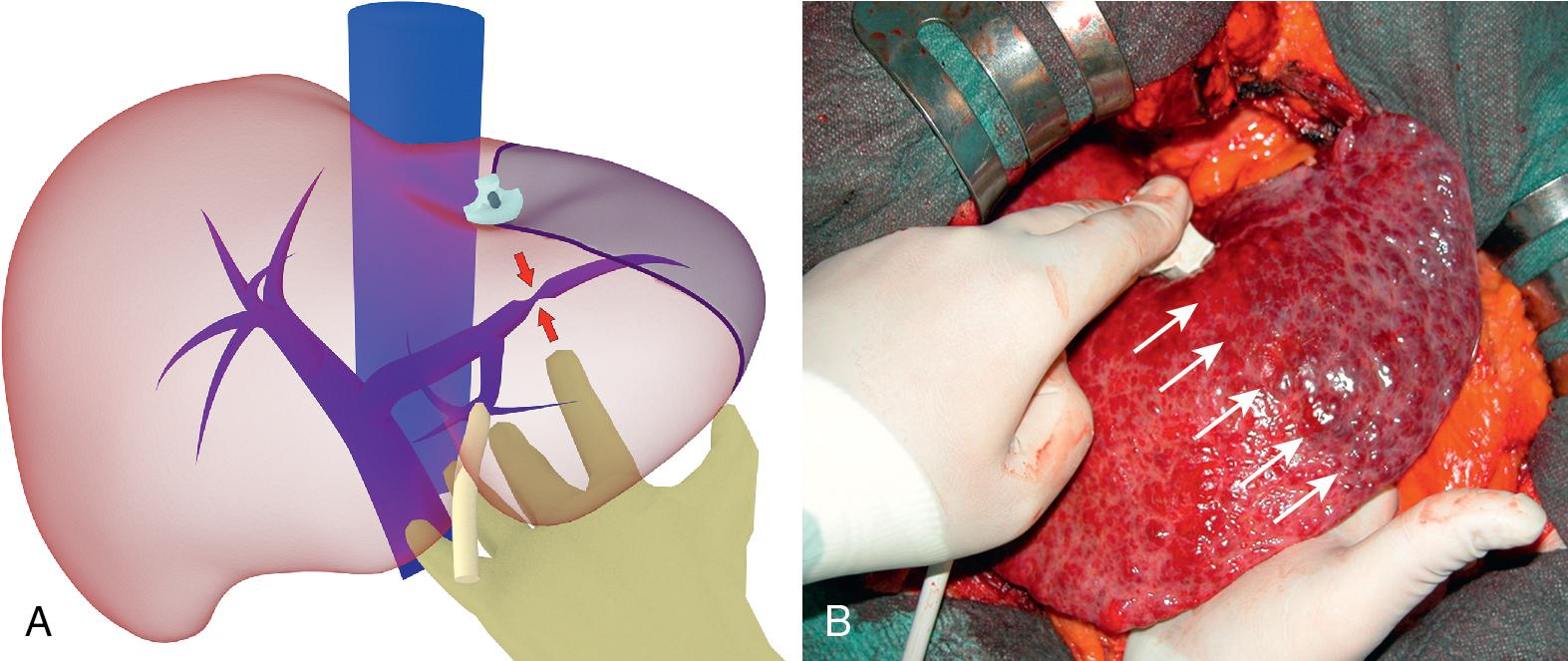
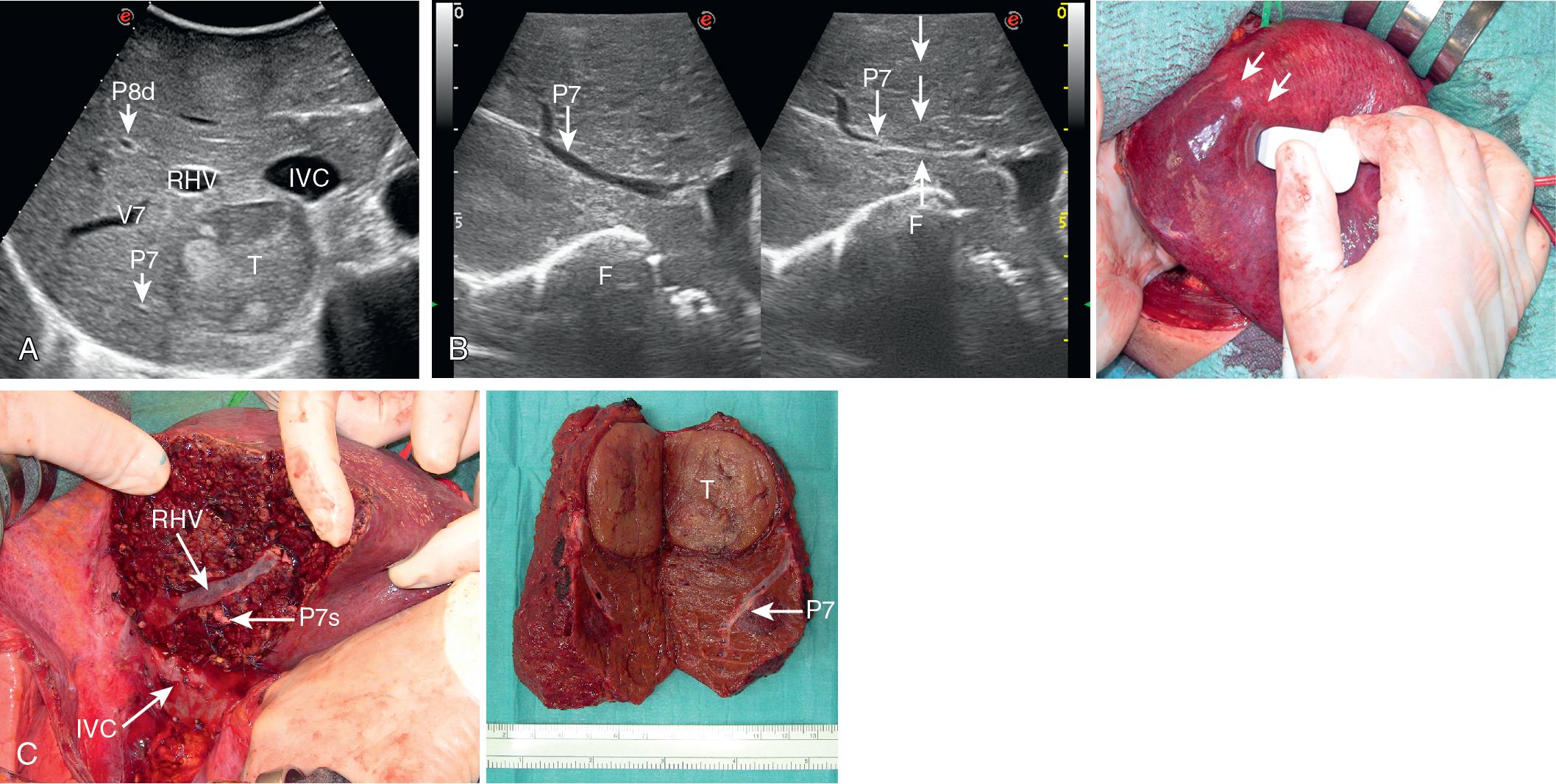
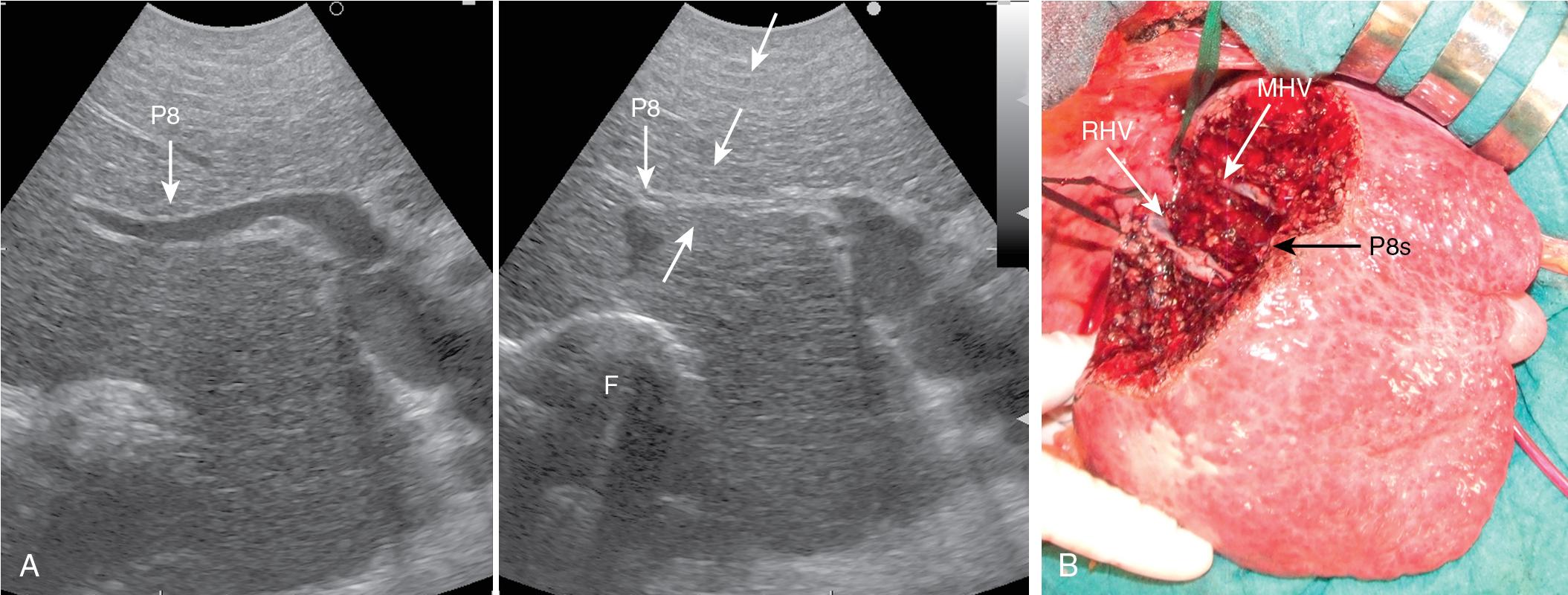

The compression can be also used in a counter-compression manner, borrowing from the counterstaining technique proposed by Takayama and colleagues for defining the adjacent segmental margins. For segments such as I and IV superior, for which direct compression of the feeding portal branch is difficult if not unfeasible, compressing the adjacent segmental branch allows for definition of their segmental margins.
In the event of HCC with tumor thrombus in the feeding portal branch, staining and compression techniques could not be performed to demarcate the segment. In such cases, intravenous (IV) injection of ICG performed by the anesthesiologist once the proper hepatic artery is selectively clamped at the hepatic hilum enables the demarcation of the segmental margin by counter-fluorescence.
As for segmentectomies, the demarcation of the sectional area to be removed is advocated. Among methods proposed for obtaining this demarcation, extrahepatic isolation of the right-sided sectional pedicles consists of careful and meticulous skeletonization of each sectional arterial and portal branch. Alternatively, the three GPs in their surrounding fibrous sheath could be encircled as a whole, with or without the use of a hepatotomy incision. As an alternative to these established techniques, the compression technique could be applied. The hepatic pedicle is encircled with a tourniquet but not dissected.
At IOUS, the portal pedicle for the right posterior section (segments VI and VII) is identified as well as the branches for segments VI and VII; the level targeted for compression is then decided ( Fig. 103.34 ). The surgeon’s nondominant hand is positioned behind the right hemiliver, and the probe is positioned with the dominant hand to show the sectional portal branch at the level of interest, which corresponds to the most distal portion of the vessel in relation to its origin but proximal to the tumor to be removed.
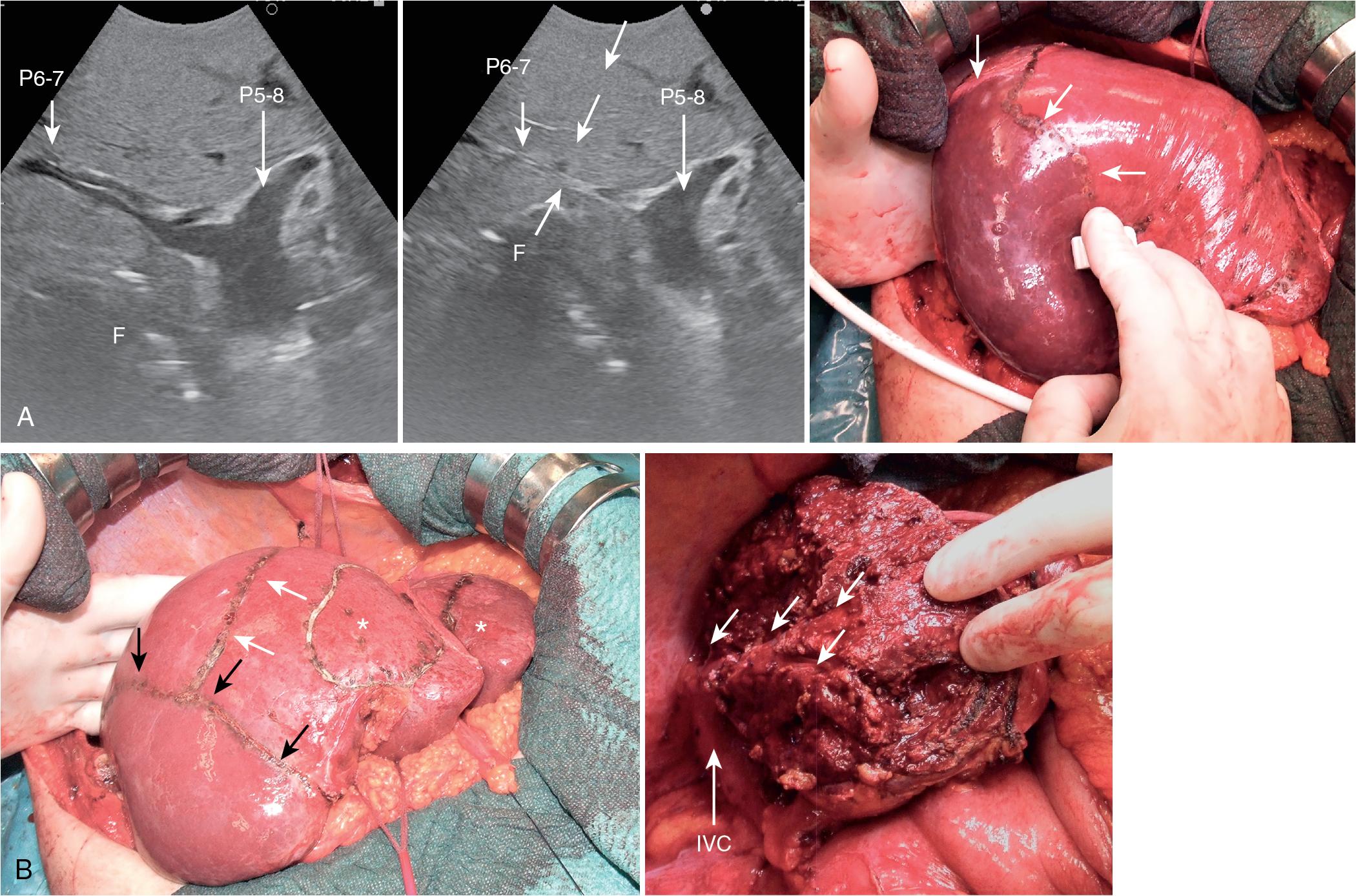
The surgeon next uses the fingertips of the nondominant hand and the IOUS probe as instruments to compress the liver bilaterally at the targeted position, resulting in compression of the sectional portal branch in the previously identified tract. When there is no common sectional pedicle to segments VI and VII, compression is applied to the respective segmental portal pedicle as previously described. This maneuver is constantly monitored in real time by IOUS by means of the probe used for compression, and compression is maintained until the surface of the right posterior section lateral to the compression site starts to discolor (see Fig. 103.34 A). At this time, the assistant marks the discolored area with the electrocautery device, and the compression is released. In this way, a three-dimensional (3D) plane has been drawn on the liver surface that passes through portal branch at the level of compression; liver resection is then carried out following this plane (see Fig. 103.34 B).
For right posterior sectionectomy, the demarcation could be emphasized adopting the counter-fluorescence technique, as described for segmentectomies.
Similarly, as for the right posterior section, the hilar dissection or the encirclement of the sectional GPs are the most commonly adopted techniques for defining the resection area in a fully anatomic manner. The counter-compression technique has also been applied for this purpose. The portal pedicle feeding the right posterior section (segments VI and VII) is identified at IOUS, and the level targeted for compression is then detected just after its origin from the right portal branch (see Fig. 103.34 A). Demarcation of the right posterior section is carried out as previously described. To demarcate the left-sided demarcation line, the left PV (LPV) is identified at IOUS, and the level targeted for compression is then identified just past its origin from the main PV. LPV compression is performed and is released once Cantlie’s line becomes evident by left hemiliver discoloration, and it is demarcated with electrocautery. Once the right anterior section is defined, resection can be performed.
In this case, the ICG fluorescence could play a relevant role as well. Counter-compression of the right posterior GP is carried out: the right anterior section and the left hemiliver become fluorescent and the right-sided dissection plane margin becomes more evident. In the event of a tumor thrombus occluding the right anterior portal branch, as described for the segmentectomy, the counter-fluorescence can be realized just by clamping the proper hepatic artery and intravenously injecting the ICG ( Fig. 103.35 ).
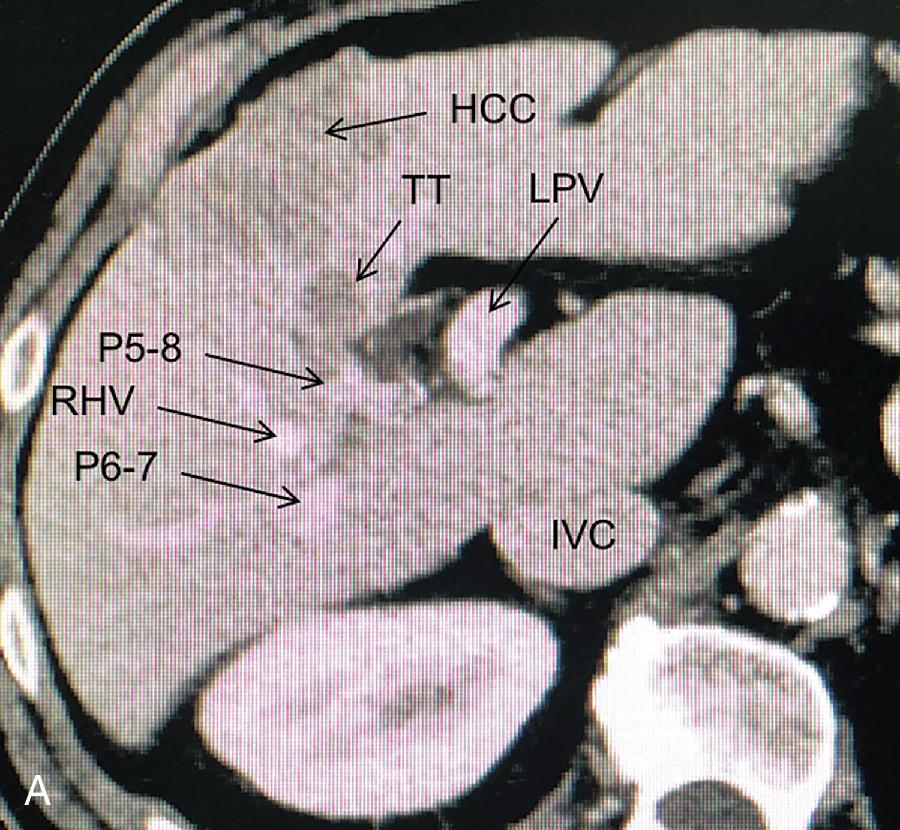
The segmental portal branches to segment IV are generally divided into two groups, those for the superior and those for the inferior portion, but the most common branching pattern can be recognized in only half of patients. As an alternative to the compression or staining techniques, the segment IV branches can be approached by dissecting the umbilical portion. Once exposed, the vessel can be encircled with a suture then pulled, under IOUS control, to verify that the branch that moves on the US machine screen is the one to the inferior portion of segment IV. Clamping that branch should allow segment IV inferior demarcation, which, upon pedicle ligation and division, can be removed selectively; this is an application of the so-called “hooking technique.” The superior portion of subsegment IV could be resected by clamping the portal branch to the inferior portion because it is identified with the hooking technique; the discolored subsegment IV inferior caudally, the plane that includes the middle HV (MHV) laterally (as seen on IOUS), and that marked by the falciform ligament medially delimit the area to be resected.
Selection of an anatomic or nonanatomic resection for HCC, although a controversial issue, is leaning in favor of the anatomic approach. , , , In contrast, limited resection is commonly accepted as an oncologically proper approach for CLM. For limited resections, IOUS guidance plays a fundamental role as well. Indeed, although there is no need to identify exactly the area of the liver fed by the portal branch to be ligated, IOUS guidance allows us to tailor the resection area unless it results smooth and warrants enough resection margin in respect to the liver anatomy and the oncologic requirements. In practice, once the tumor is identified on IOUS, the surgeon can mark the border of the lesion and that of the area to be removed on the surface of the liver with electrocautery under IOUS control. To perform this maneuver, the flat and thin tip of the electrocautery device is positioned between the probe and the liver surface. This results in a shadow on the IOUS image that runs deep just below the electrocautery ( Fig. 103.36 A). In this way, it is possible to define the position of the electrocautery device with the tumor edge and consequently to mark the nodule profile on the liver surface with electrocautery and select the safer edge for the incision. The adequacy of the marked edge can be further checked with IOUS because the air trapped between the probe and the irregular surface of the demarcation line drawn with electrocautery on the liver surface can be visualized on IOUS and are similar to the images that result from electrocautery ( Fig. 103.37 ).
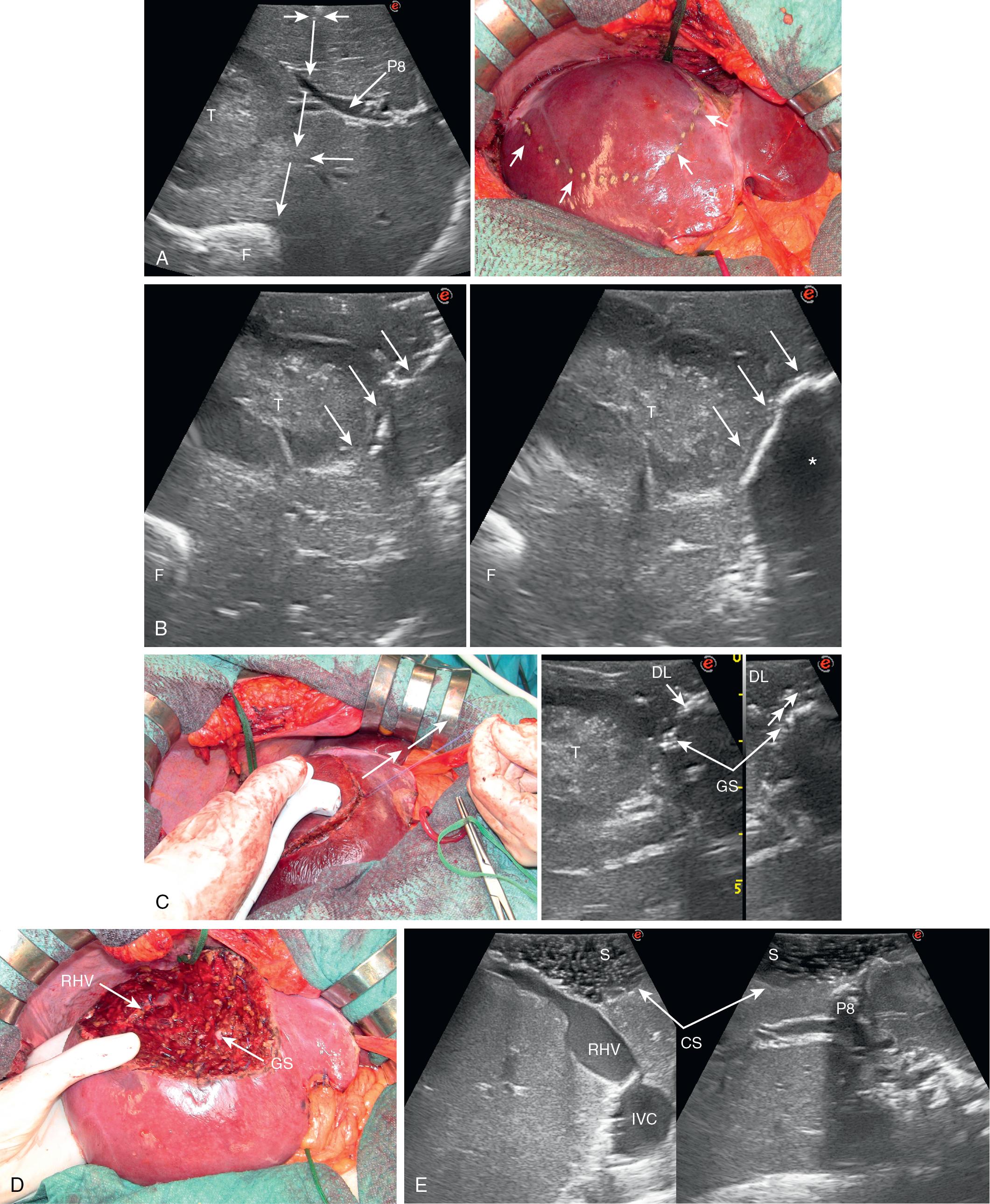
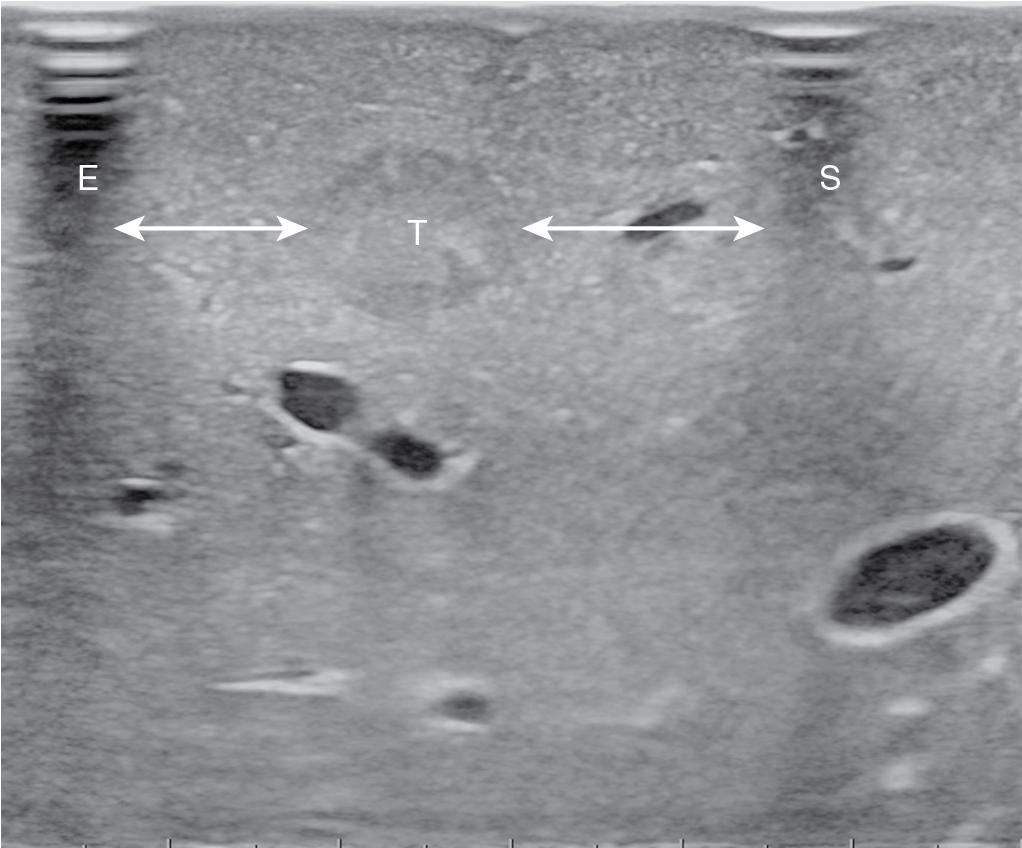
Additionally, with the probe positioned on the liver surface at the site of the resection margin previously drawn, the surgeon can use a fingertip to push at the opposite edge of the resection area so that the profile of the resection area is visualized on IOUS (see Fig. 103.36 A). Consequently, structures between the fingertip and the tumor edge can be precisely estimated, the resection area can be marked on the liver surface, and the dissection plane is visualized. Once the resection area is drawn on the liver surface, the main target to be obtained is such that at the end of the dissection, the cut surface is oriented smooth and regular (see Fig. 103.36 D).
The main advantage of IOUS-guided resection is that it modifies the traditional way to dissect the liver tissue, which was originally done on vertical planes to avoid the tumor exposure on the cut surface. IOUS allows the surgeon to follow the dissection plane in real time, to see it constantly in relation to the tumor edge, and then to modify its direction when needed. This is because the dissection plane can be visualized on the IOUS image, which appears as an echogenic line because of the entrapment of air bubbles and clots between facing cut surfaces (see Fig. 103.36 B). If the dissection plane is not clearly visible, it can be better visualized by inserting plain gauze (see Fig. 103.36 B) between facing surfaces. These techniques allow the surgeon to keep the proper dissection plane and recognize an improper one early. In this way, it is possible to carry out a rounded trajectory of the dissection plane around the tumor, avoiding tumor exposure, its eventual disruption, and potentially cancer seeding, as well as allowing the surgeon to spare important vascular structures. This results in more conservative but radical treatments and in a lower rate of major hepatectomies.
The artifacts that may appear on IOUS sometimes mask structures critical to the dissection plan, such as portal branches, which should be either ligated or preserved. For this reason, to better visualize the targeted point where the portal branch should be divided, the “hooking technique” has been devised. When the Glissonean sheath is exposed and skeletonized, it is encircled with a stitch. Under US control, the stitch hooking the exposed vessel is then gently pulled up, which stretches the portal branch slightly; this traction point is demonstrated clearly by IOUS (see Fig. 103.36 C). If the exposed portal branch is not clearly visible because it has collapsed, the portal triad is unclamped. If the target site is correct, the portal branch is ligated and divided, and resection is completed under IOUS guidance. Conversely, if the exposed vessel was not the targeted one, it is spared, and unnecessary sacrifice of further liver parenchyma is avoided.
A practical example of using the hooking technique is during ventral or dorsal subsegmentectomy of segment VIII. The portal trunk to this segment may show bifurcation in its dorsal branch and ventral trunk near the origin of the portal vessel to segment V. In this situation, there is the risk of ligating and dividing the portal branch of segment V, instead of the planned subsegmental branch of segment VIII, and necrosis of segment V may occur. Under IOUS control, the hooking technique enables the identification of the branch, which was encircled, and then the surgeon can decide with certainty whether to ligate it.
The hooking technique is also useful with tumor thrombus in portal branches. Once the portal branch is skeletonized, it is encircled with a stitch, which is gently pulled up under IOUS control; this traction stretches the portal branch slightly, and the traction point is demonstrated clearly by IOUS ( Fig. 103.38 ). If the traction point is not at the level of the tumor thrombus, it is possible to ligate the portal branch and proceed with the liver resection, ensuring that the thrombus will not migrate because of surgical manipulation.
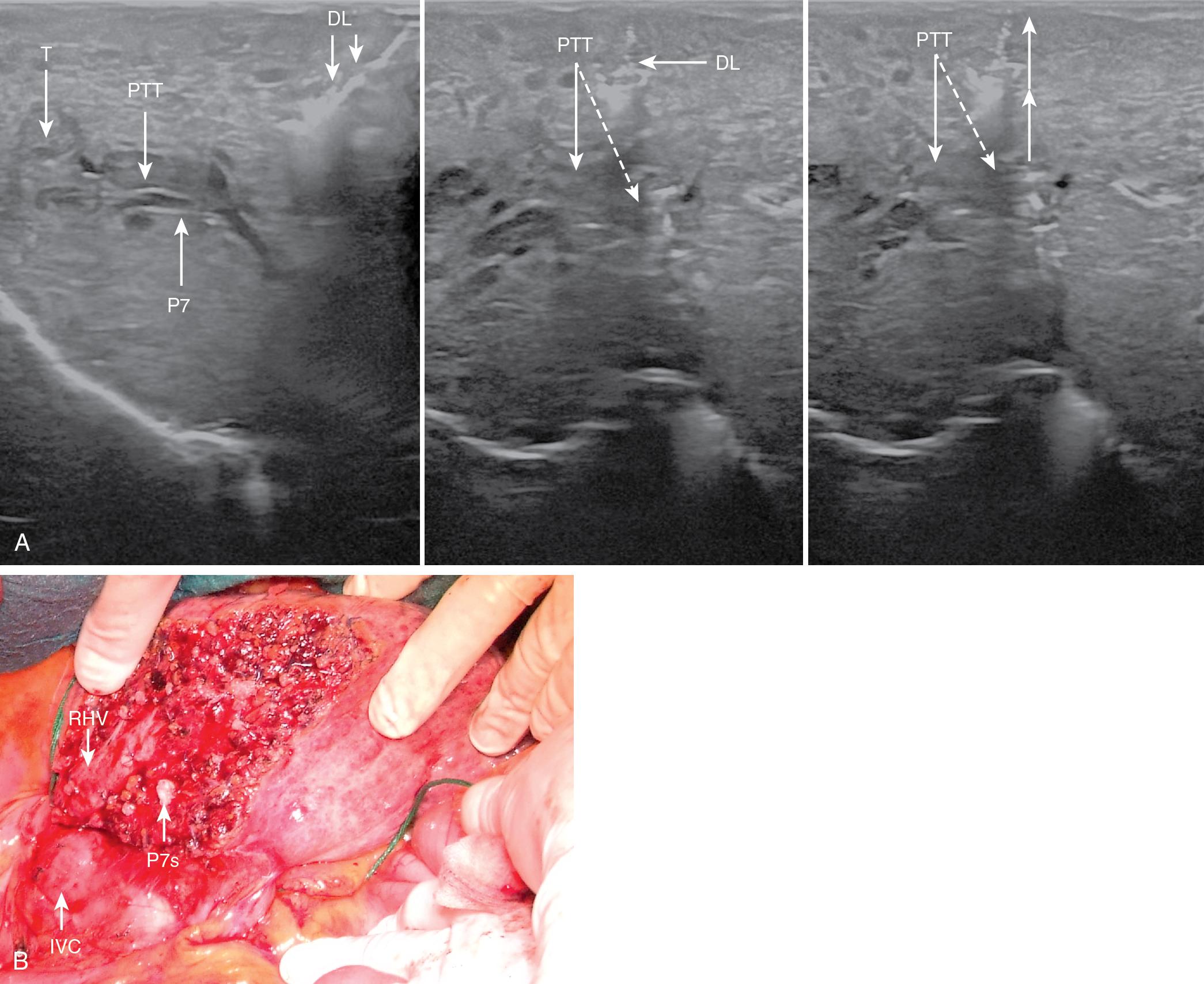
During liver dissection, the backflow bleeding from the HVs is an important source of blood loss, and it is one of the most important factors in determining the short- and long-term outcome; therefore limiting the backflow bleeding from the HVs is a priority in liver resections. A US-guided technique is simple and effective for backflow bleeding control. Once the hepatocaval confluence is exposed anteriorly ( Fig. 103.39 ), dissection proceeds until the surgeon’s fingertip is able to compress the targeted HV at its caval confluence; the effectiveness of this maneuver is checked by color flow (CF)–IOUS ( Fig. 103.40 ).
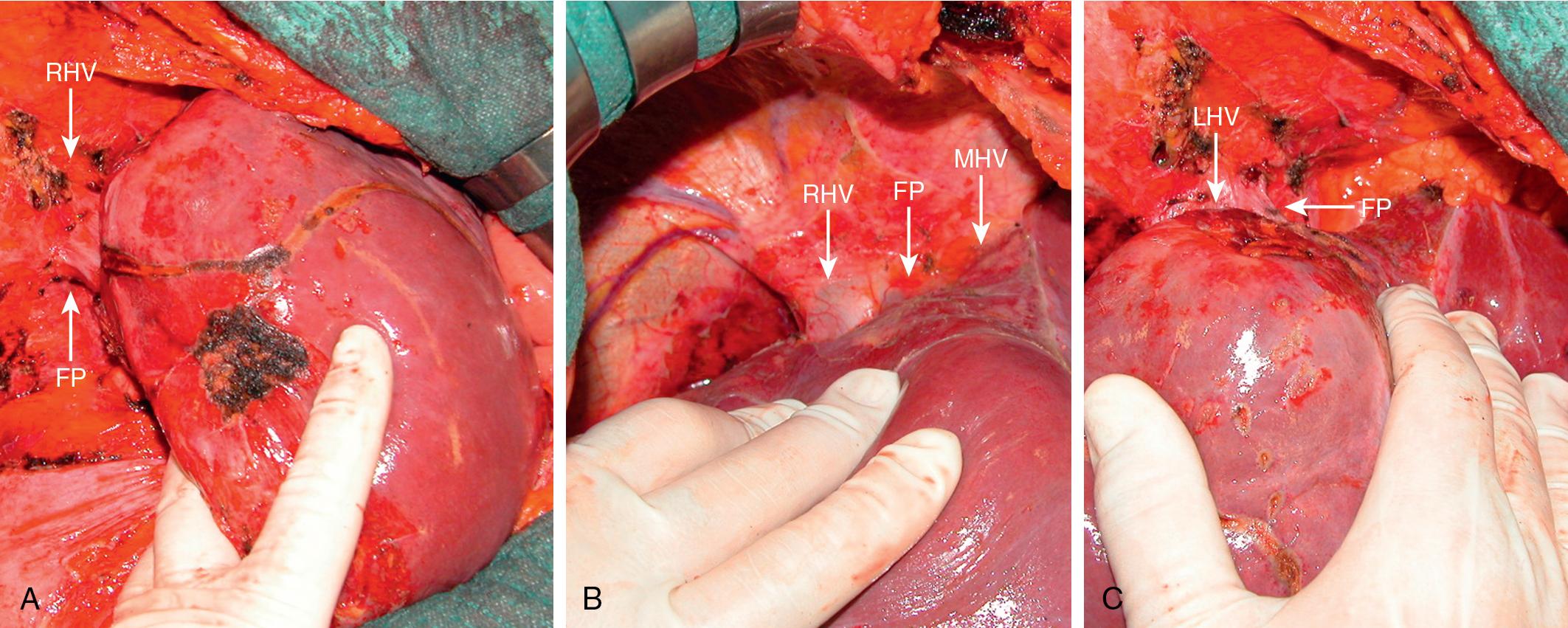
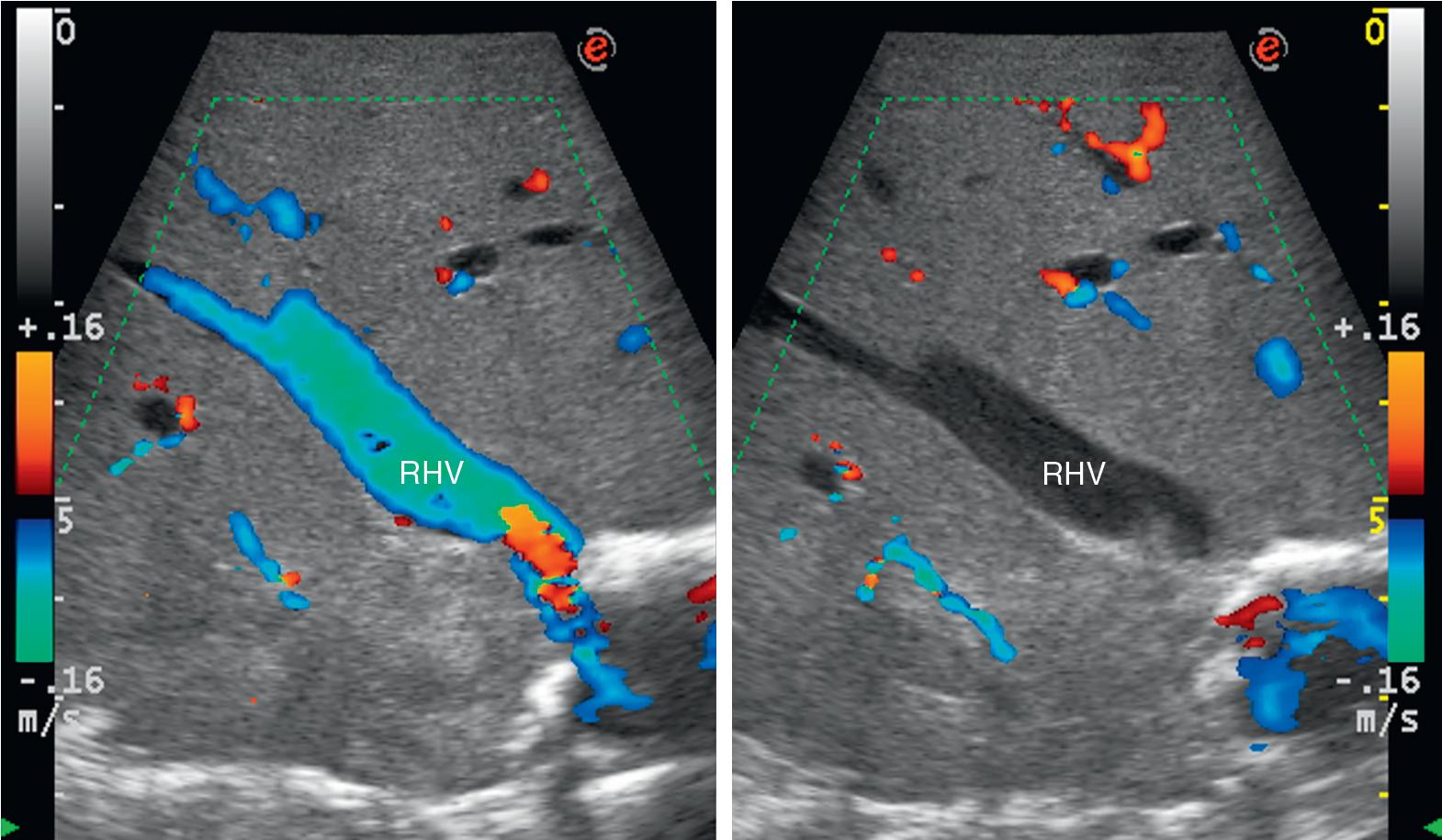
After nodule removal, IOUS offers two options for specimen handling. The “water bath” technique consists of real-time control of the proper resection of the targeted nodule, verifying its complete inclusion in the specimen removed from the liver ( Fig. 103.41 ). The second option involves checking the cut surface, which is refilled with saline to avoid the artifacts generated by the residual air bubbles and clots ( Fig. 103.42 ; see also Fig. 103.36 E).
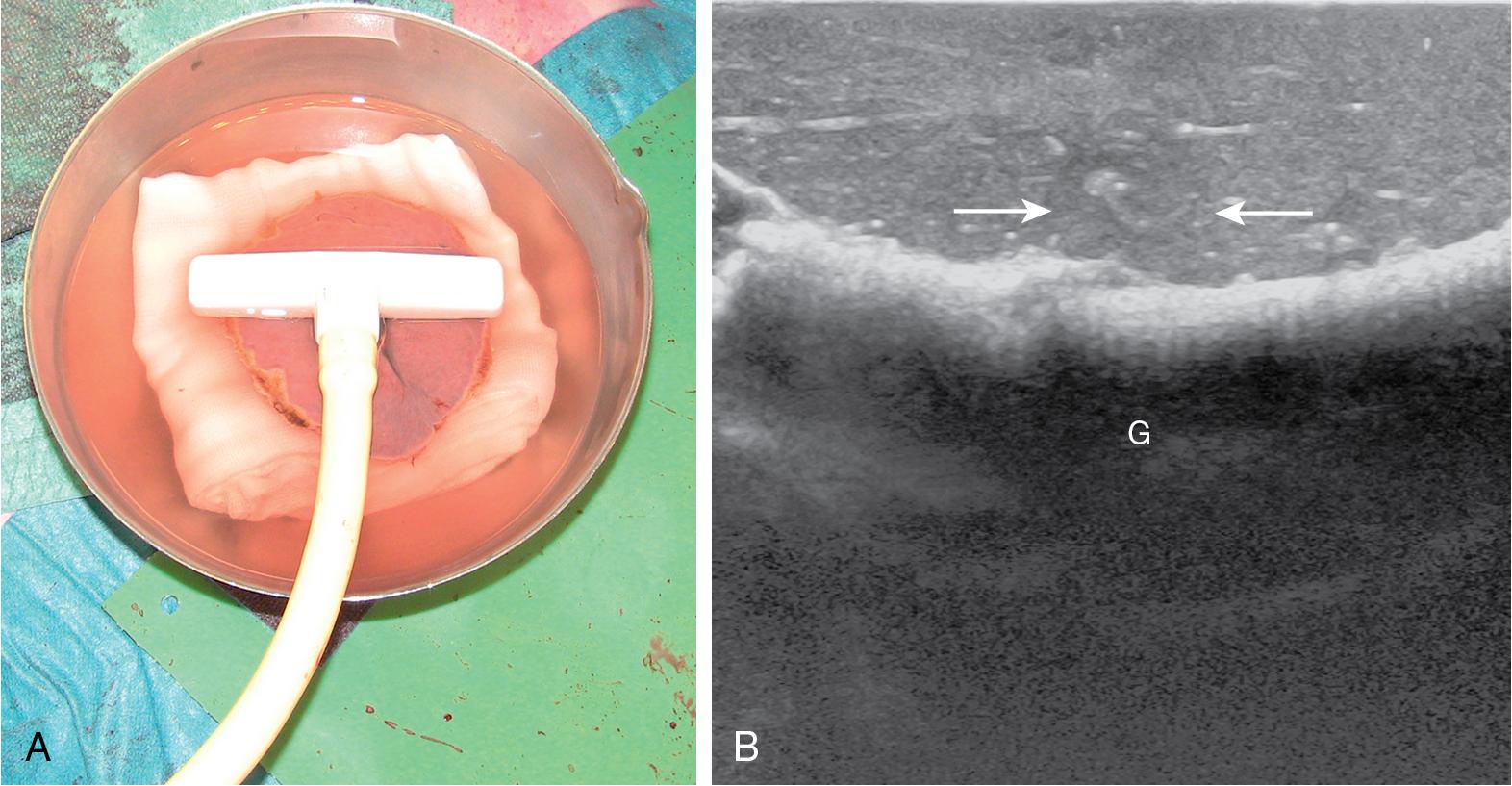
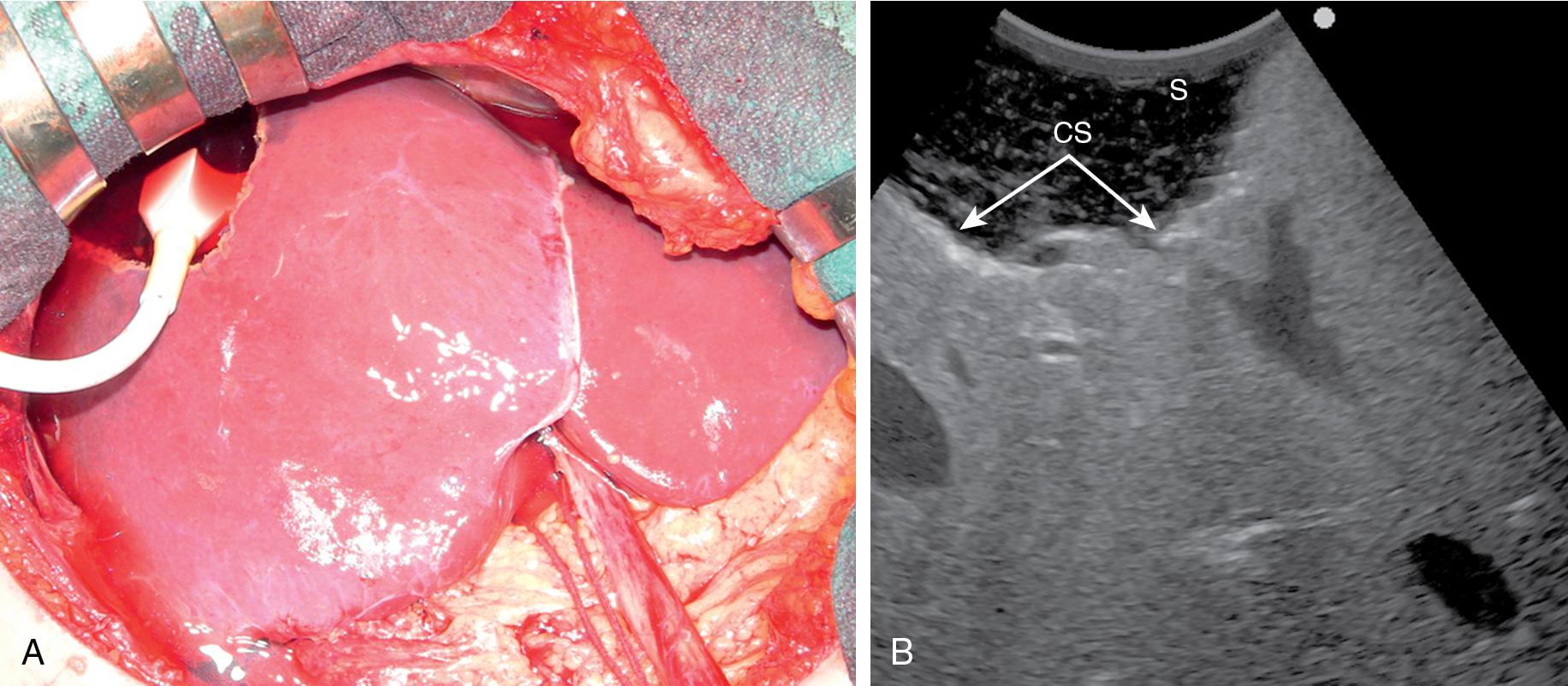
In patients who require major resection, color Doppler IOUS allows the proper positioning of the remnant liver such that there is no partial occlusion or turbulence of the inflow and outflow in terms of velocity and waveform ( Fig. 103.43 ).
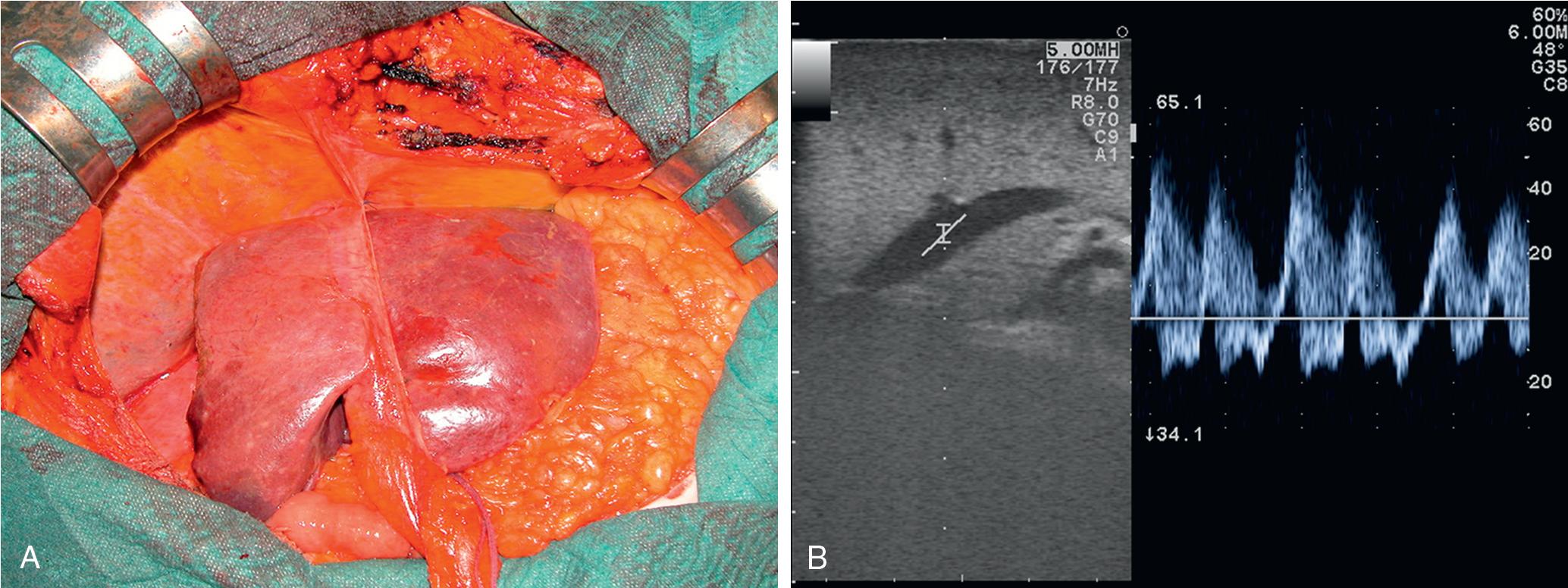
Become a Clinical Tree membership for Full access and enjoy Unlimited articles
If you are a member. Log in here